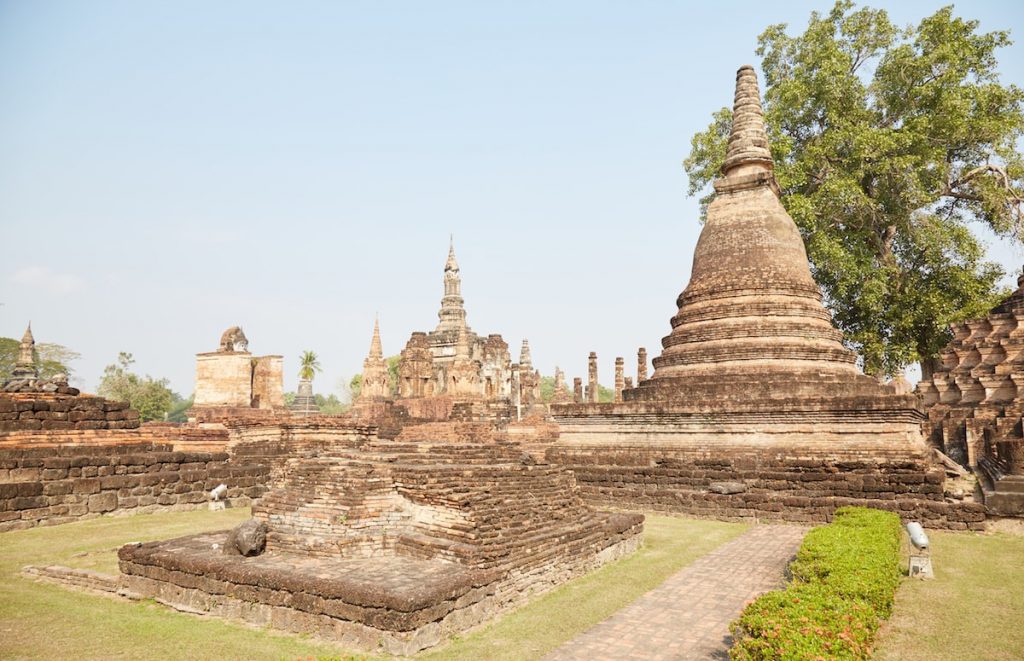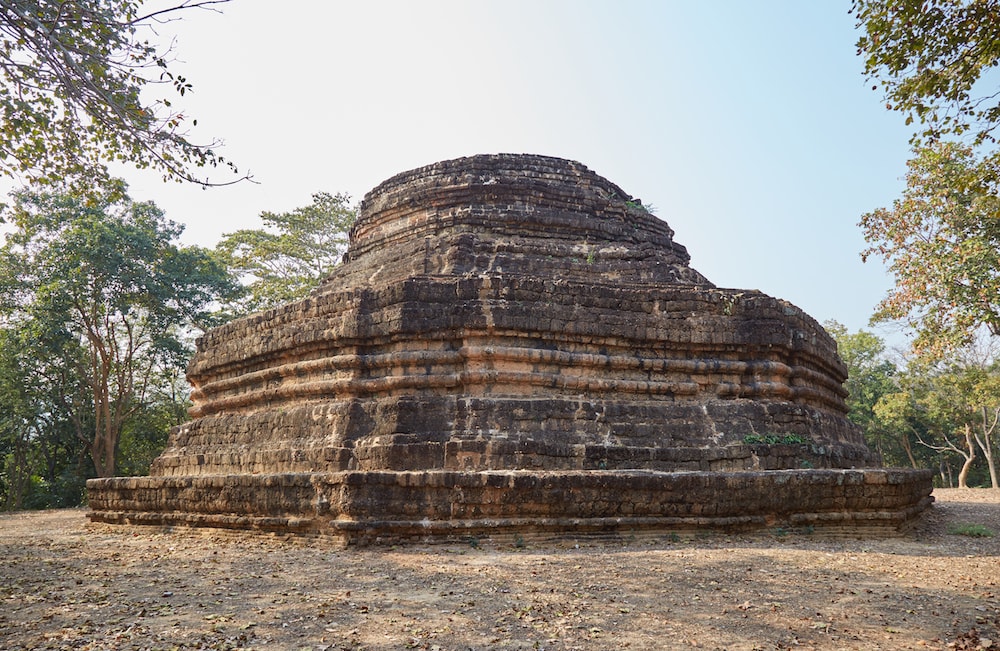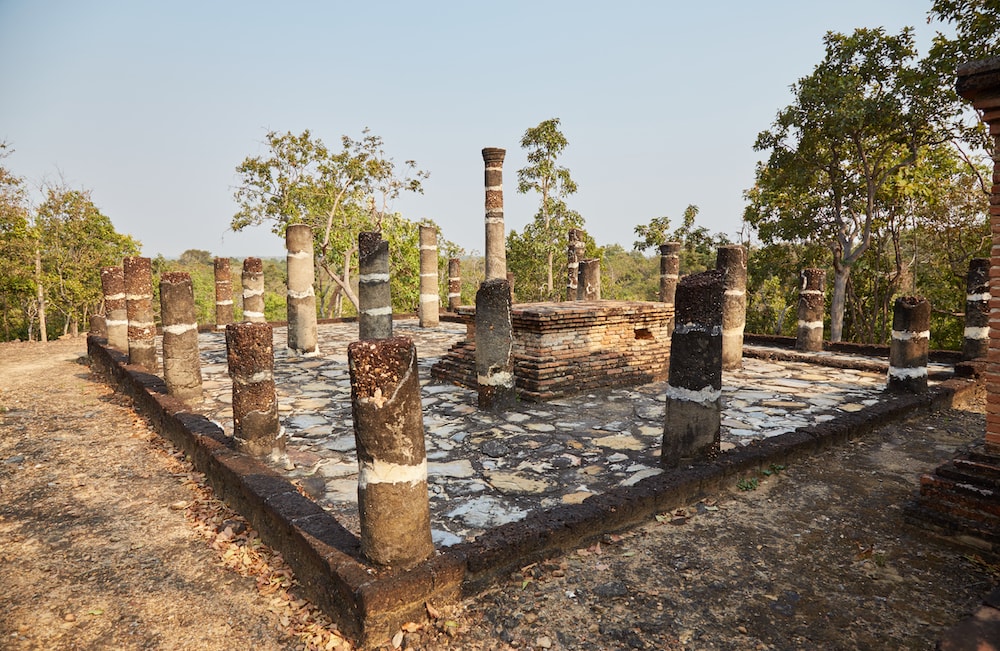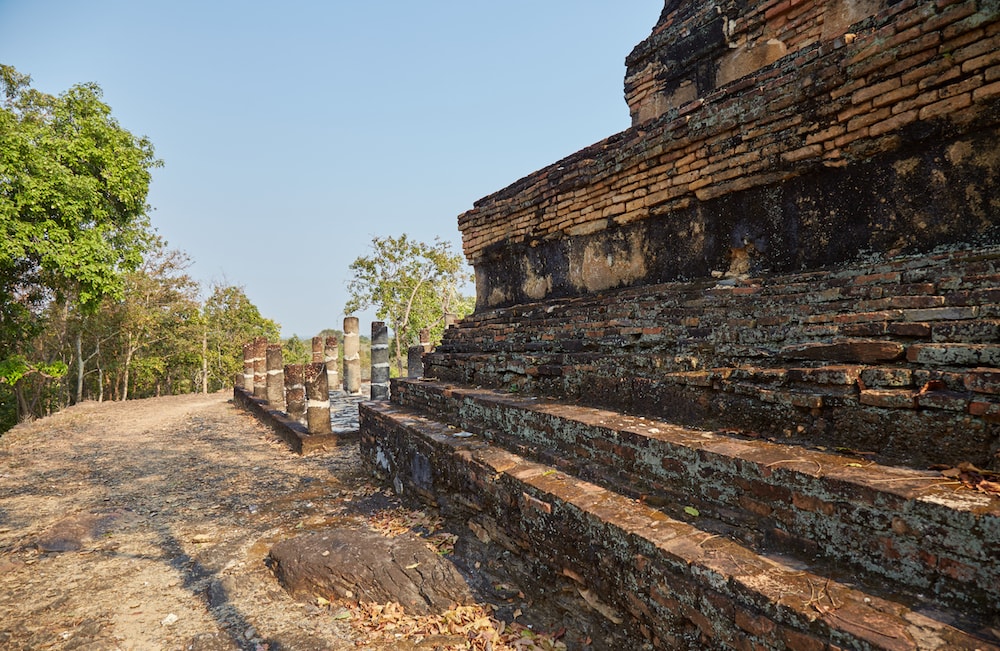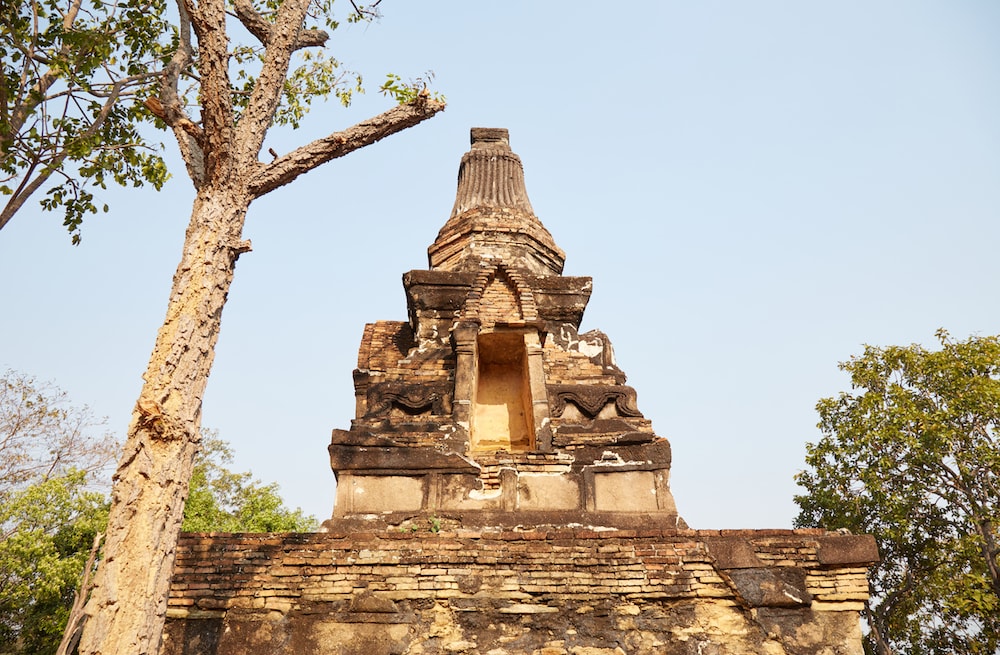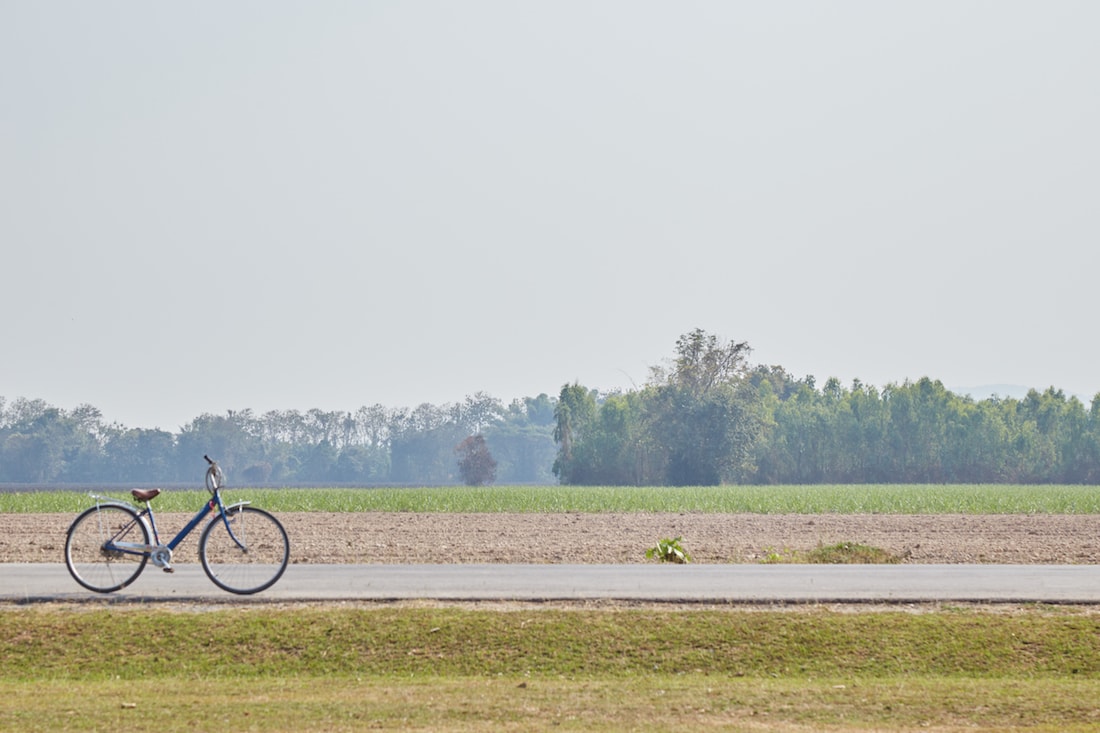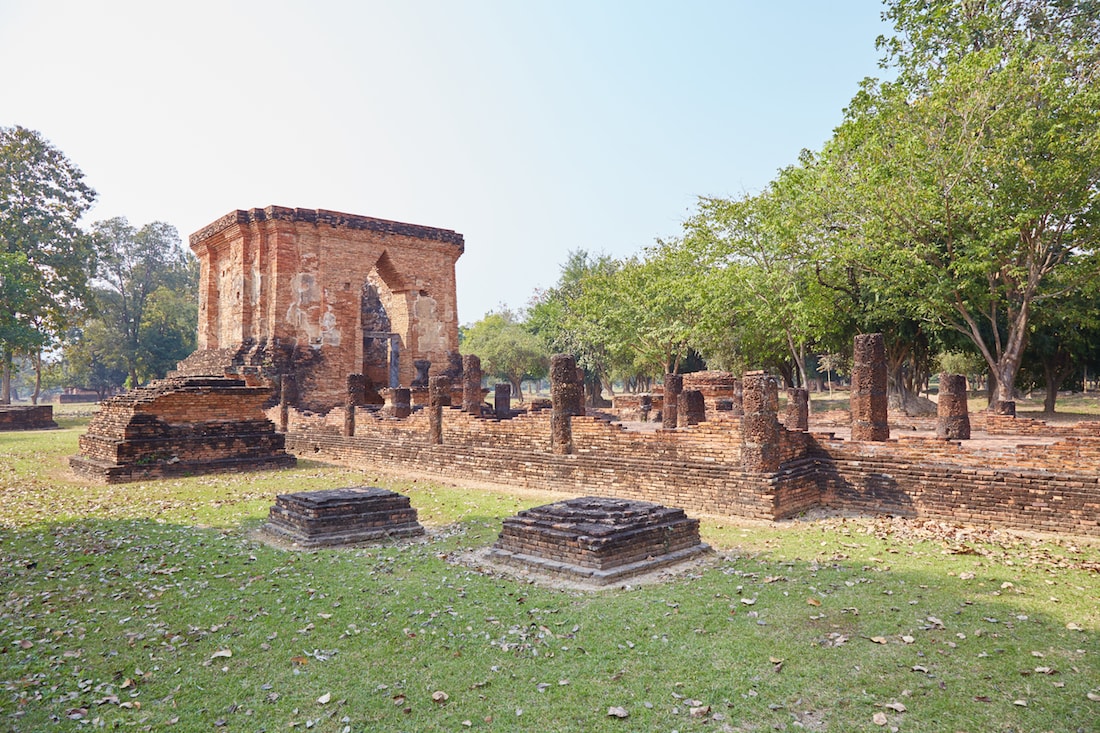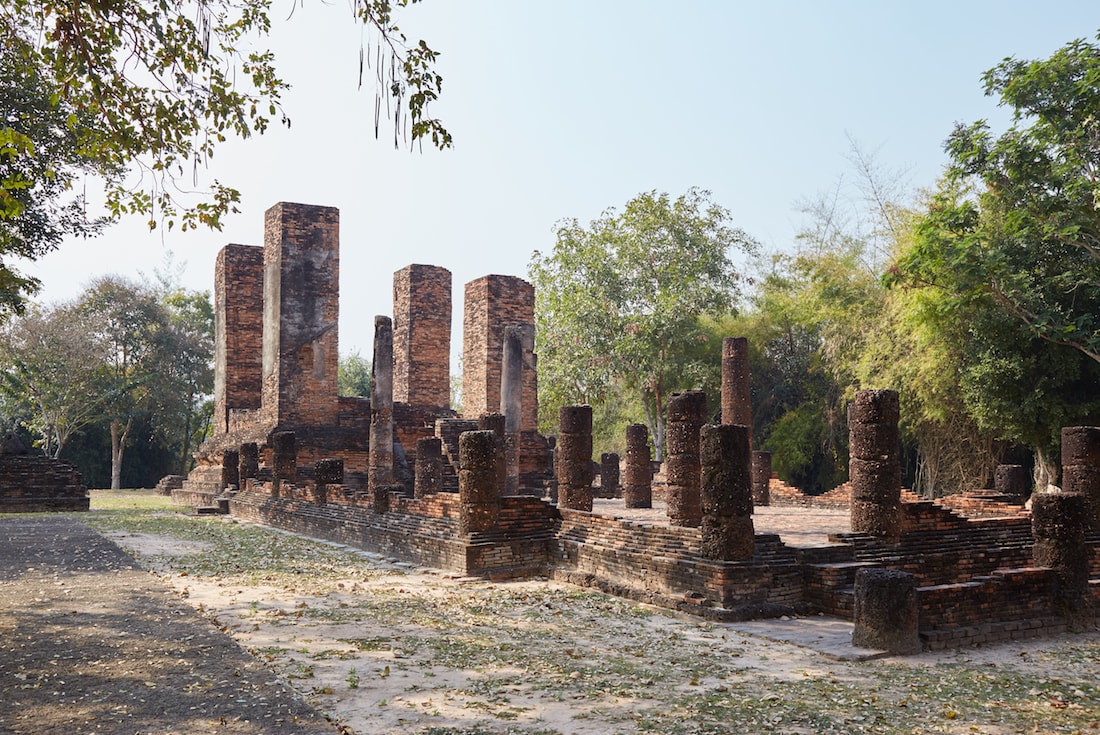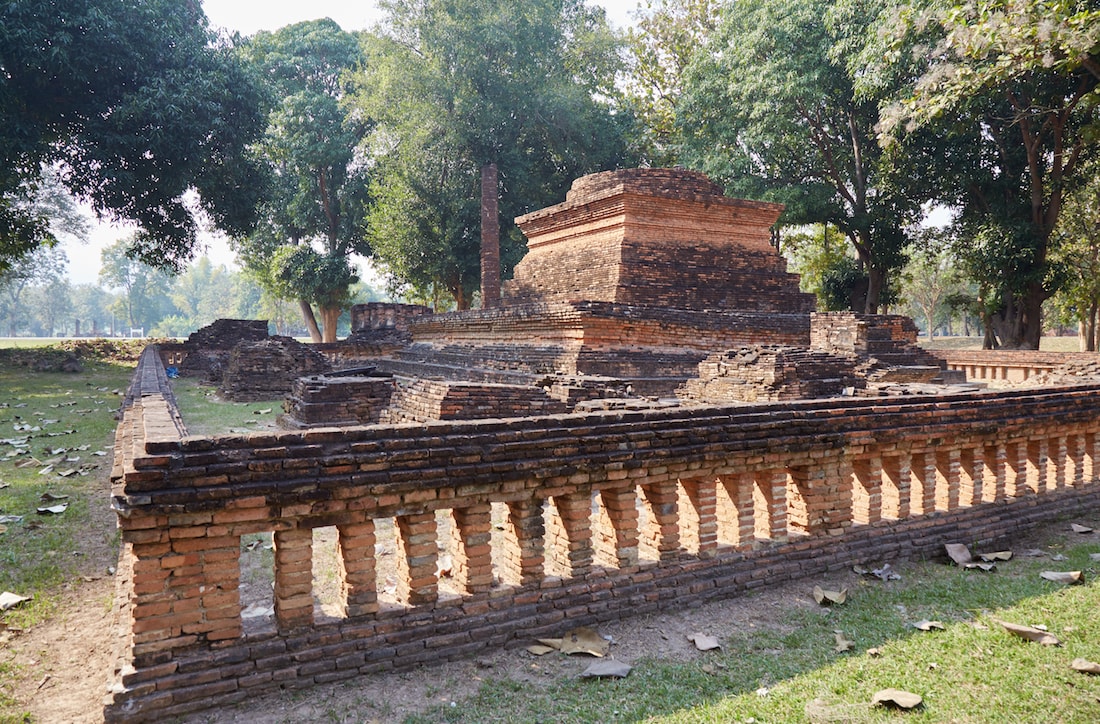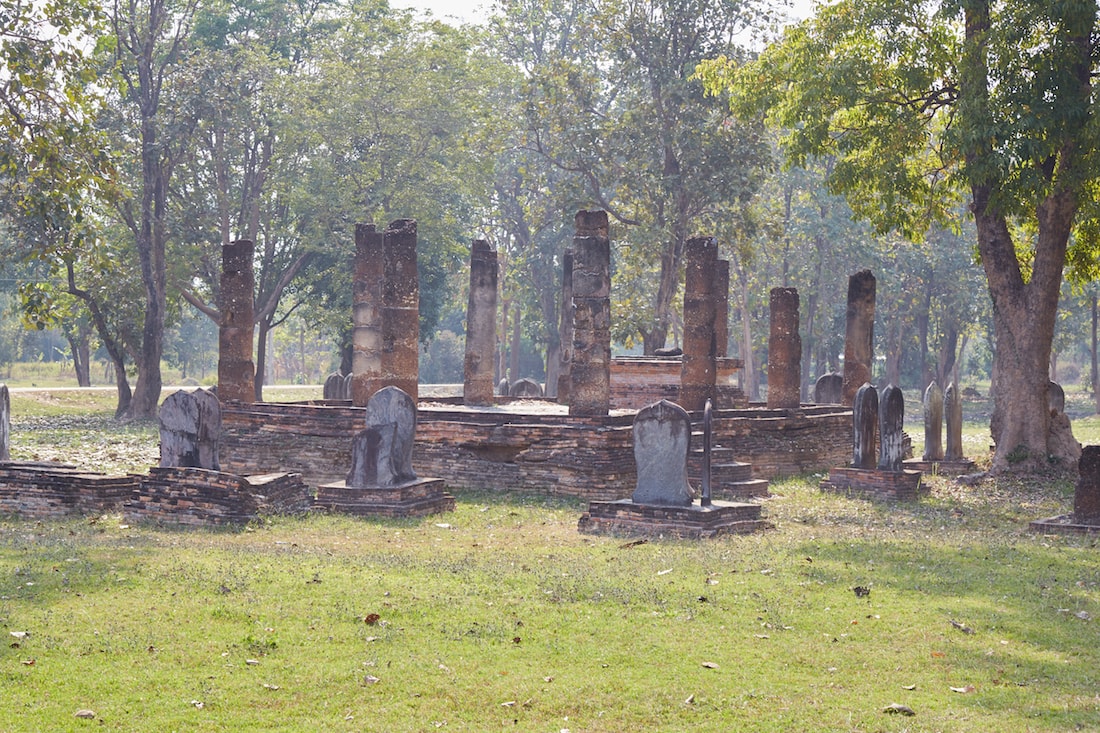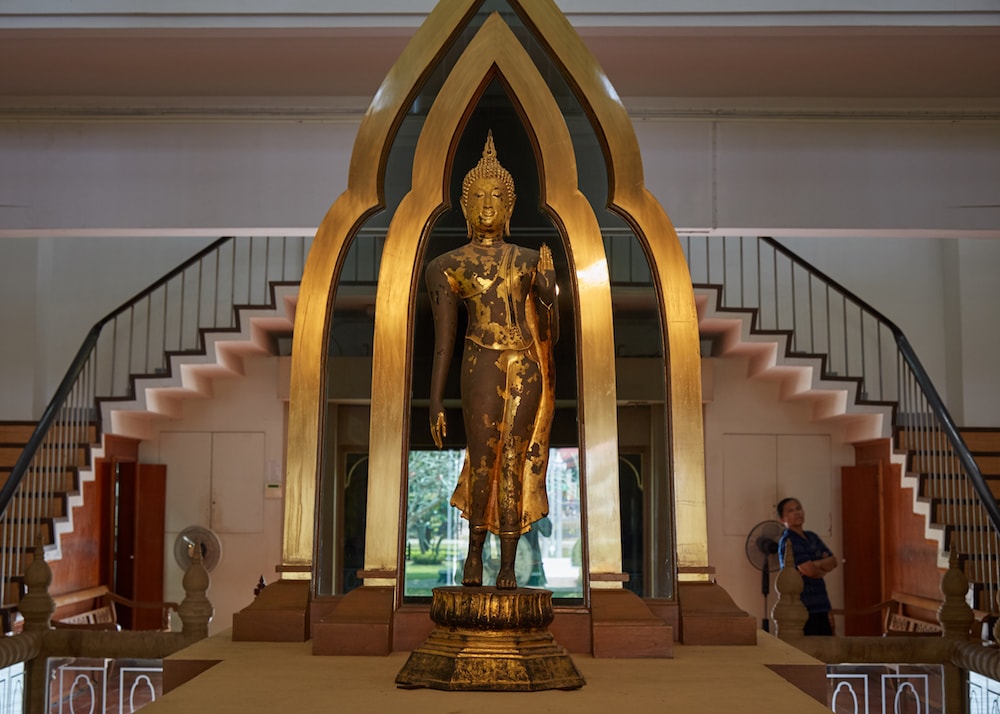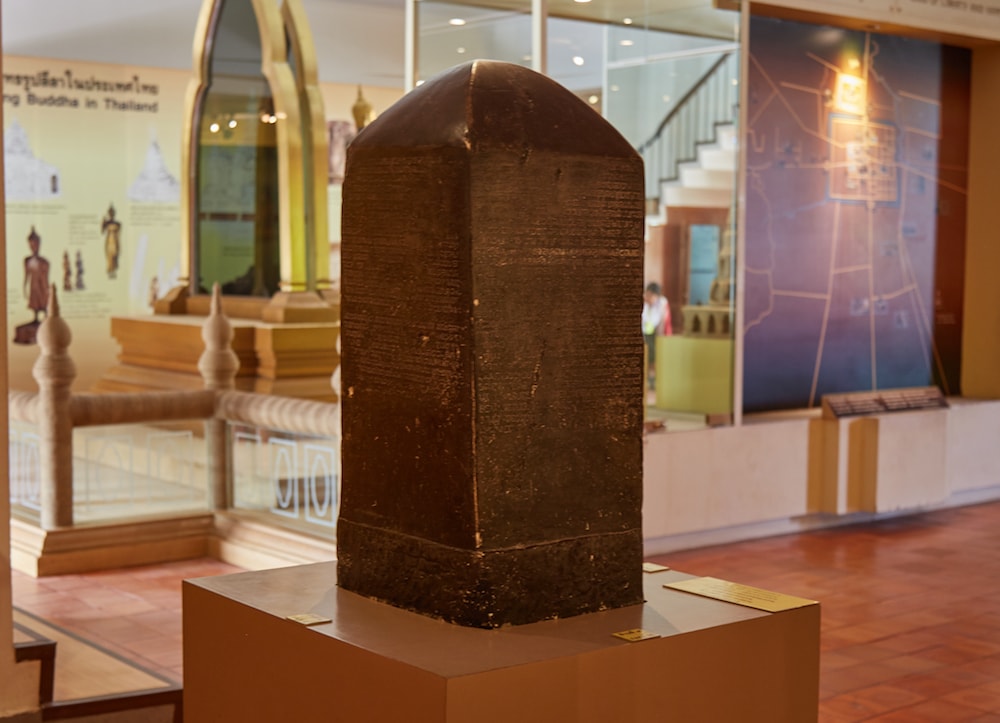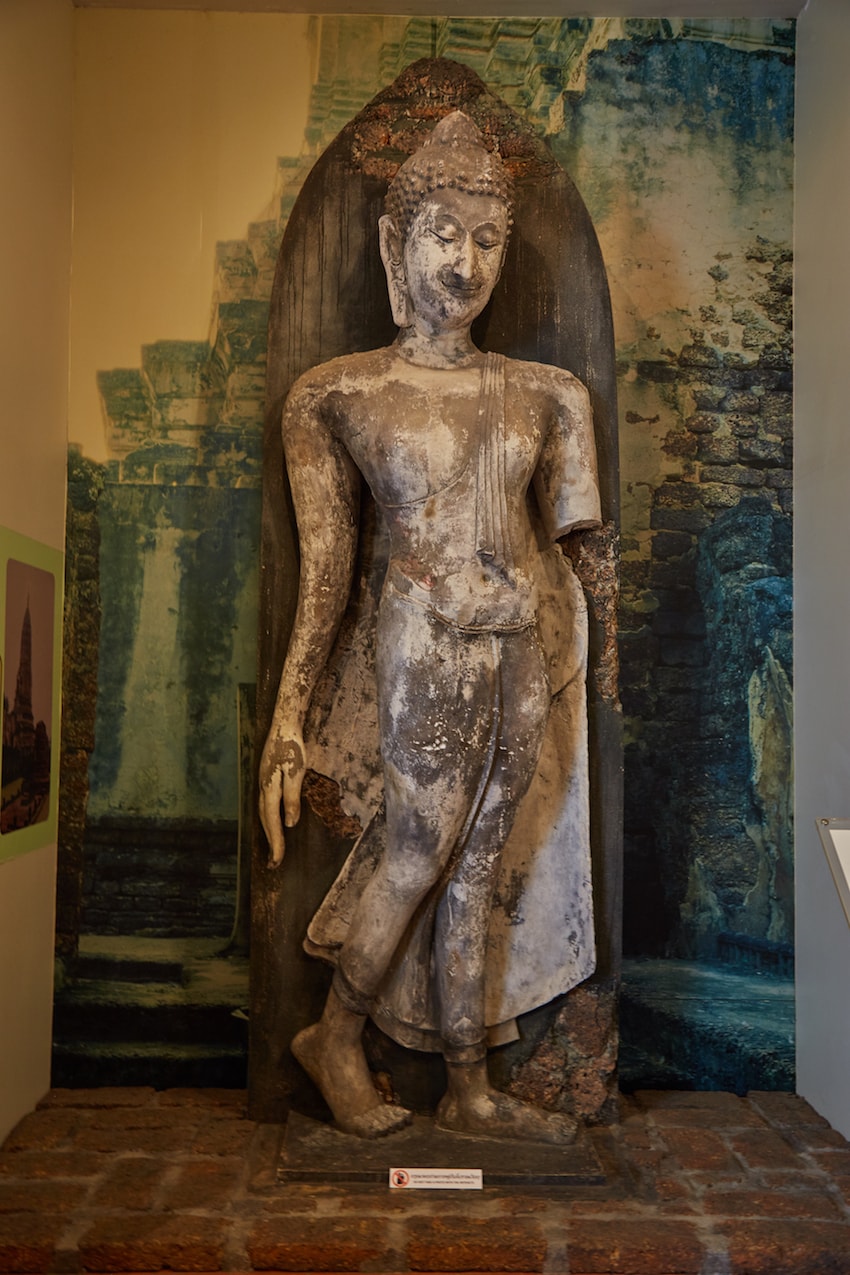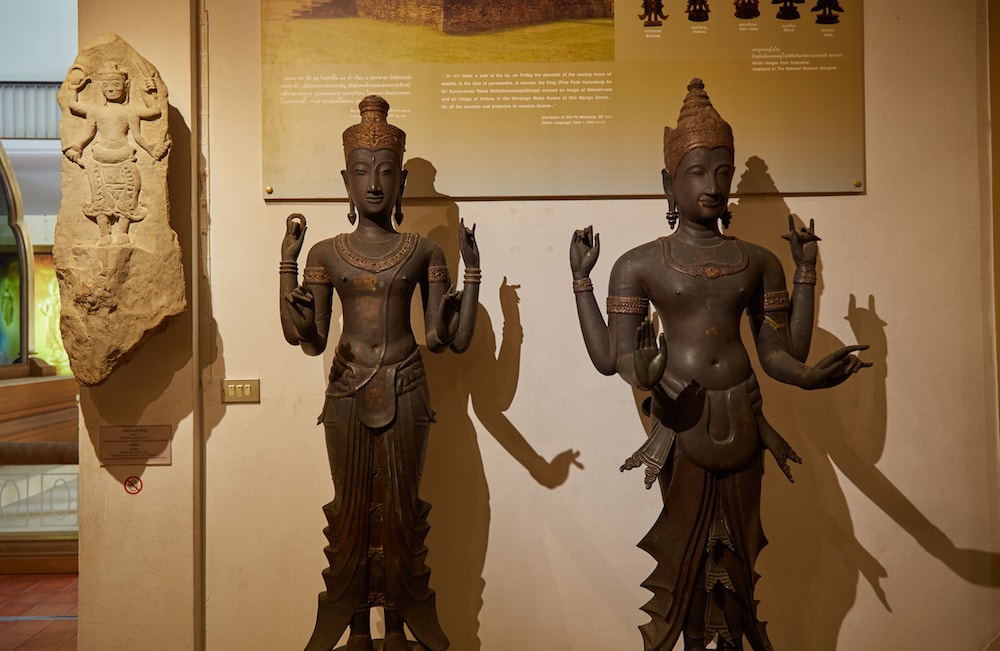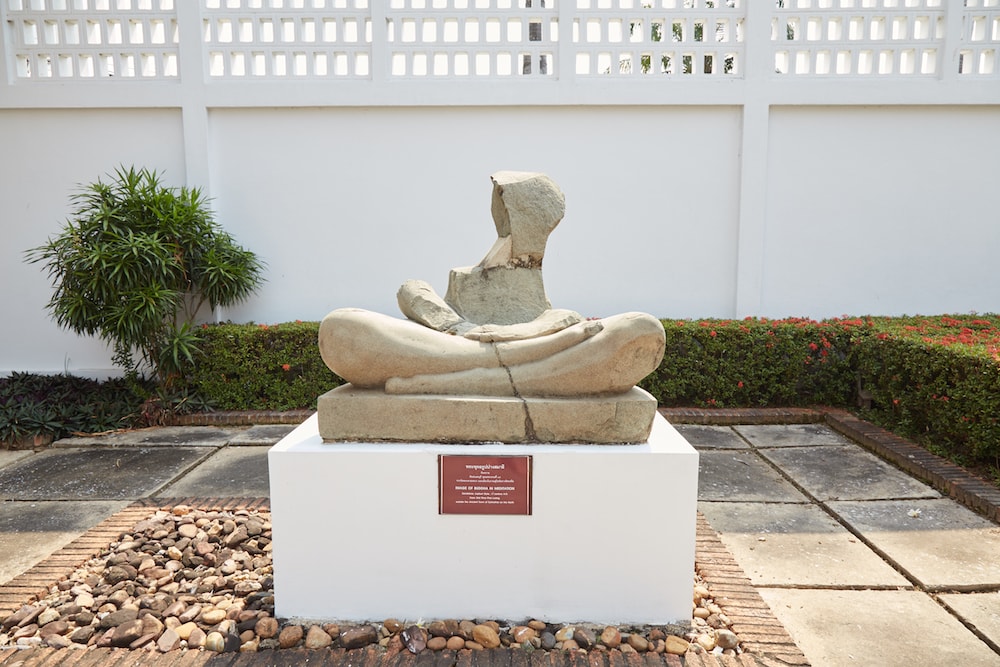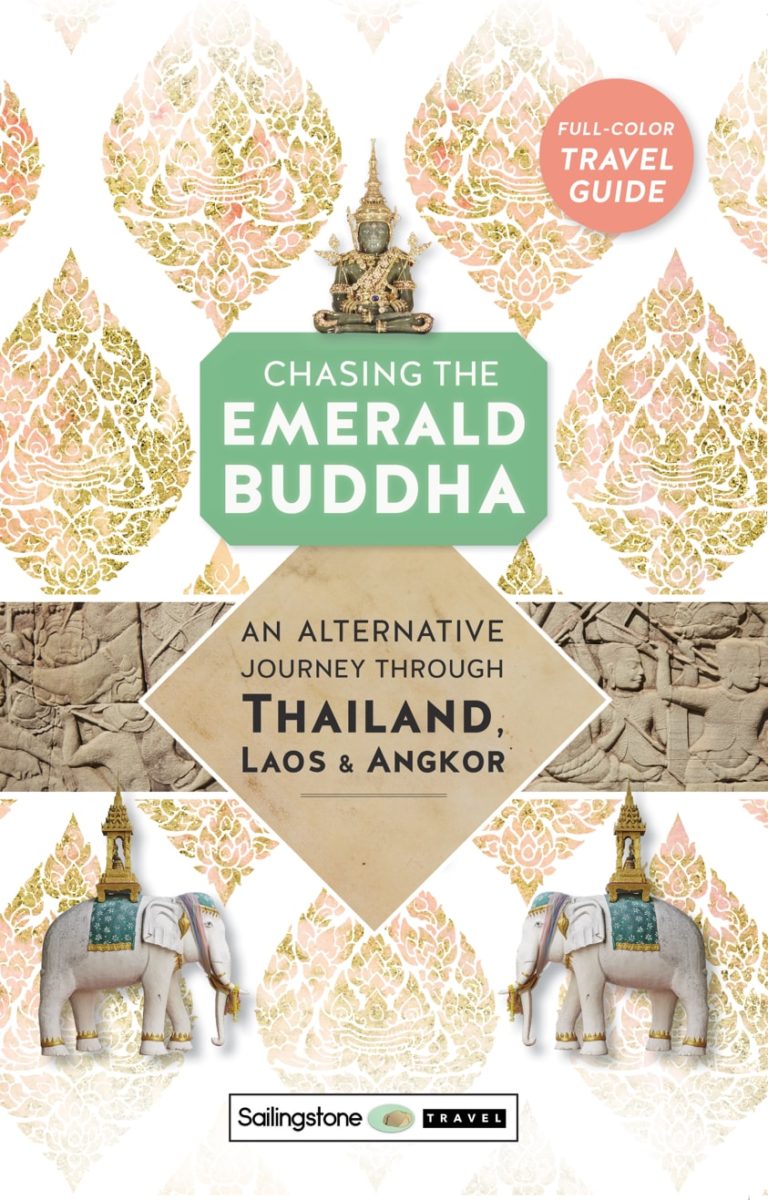Last Updated on: 27th January 2020, 11:34 am
Sukhothai is one of Thailand’s most important historical and cultural sites, boasting some of the country’s most impressive ruins. The ancient temples span from the 12th to the 16th centuries and blend together a myriad of architectural styles. On top of that, Sukhothai is also the perfect getaway for scenic bike rides through the Thai countryside. In this comprehensive guide, we’ll go over strategies to independently explore Sukhothai Historical Park, along with information on just about every temple the site has to offer.
Exploring Sukhothai Historical Park
The Sukhothai Historical Park consists of five different zones:
Everything mentioned in the article below can be seen over the course of two days, provided you’re getting around by bicycle. While several lesser significant temples may be missing, the following article covers nearly all there is to see in Sukhothai.
If you only have a single day to explore the ruins, stick to the Central and North Zones. The South and East may be less impressive temple-wise, but they’re the most scenic and enjoyable areas to explore by bicycle.
The Ticketing System
The ticketing system for Sukhothai is pretty straightforward. Each of the five zones mentioned above requires its own ticket. Though combination tickets once existed in the past, they no longer do.
Officially, each zone costs 100 baht, and you also have to pay a surcharge of an additional 10 baht if you’re on a bicycle. You might discover, like I did, however, that the South and East Zones do not have any ticket checkers and are completely free to enter. Of course, this could always change. Also be aware that there are a number of worthwhile temples in between the zones that are always free. These will be specified in the article below.
Sukhothai: a Brief History
Sukhothai started out as an outpost of the Khmer Empire, based in Angkor, Cambodia. But all that changed in 1238, when the former vassal state successfully revolted and declared its independence. Made up of an ethnic Tai majority, independent Sukhothai is widely recognized as the first Siamese kingdom.
Sukhothai’s first ruler was Si Inthrathit who founded the Phra Ruang dynasty. He would soon transform Sukhothai from a city-state into an empire, conquering much of the territory throughout the upper Chao Phraya valley. Meanwhile, he began building the royal temple of Wat Mahathat at home, contributing the central chedi which still exists today.
It would be Si Inthrathit’s younger son, though, who would bring Sukhothai to its greatest height of power. King Ram Kamhaeng expanded Sukhothai’s territory as far east as Luang Prabang, and as far south as Nakhon Si Thammarat on the Malay peninsula.
As Nakhon Si Thammarat long had close ties with Sri Lanka, this also led to easier communication between Sukhothai and that island nation. Sukhothai would soon adopt Sri Lanka’s brand of Theravada Buddhism as its official religion. However, Khmer influence, such as the role of Brahmanic priests in civil and religious matters, would persist.
After King Ram Kamhaeng’s death, Sukhothai lost much of its grip on its former territories. Over time, Sukhothai went from being a mighty empire back to little more than a regional power. And as the Ayutthaya Kingdom continued to grow, they forced Sukhothai to become their own tributary state in 1349. Eventually, Sukhothai was completely absorbed into Ayutthaya’s territory by 1438.
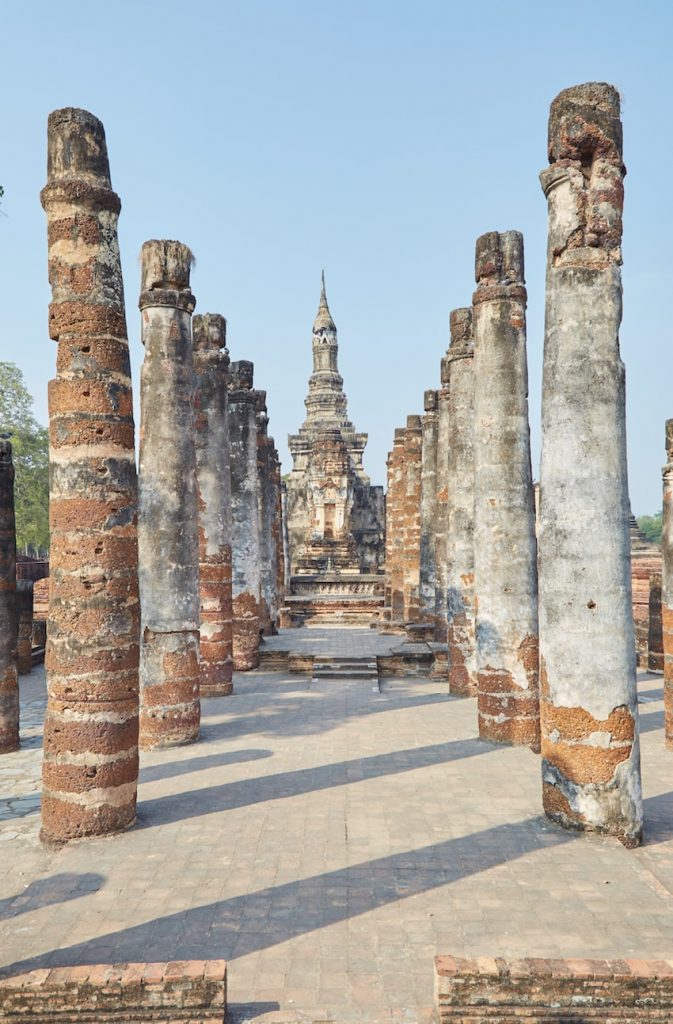
During their rule over Sukhothai, the Ayutthaya Kingdom continued to build new structures as well as add to already-existing temples. Therefore, what you see in Sukhothai today is a unique combination of Khmer, Sri Lankan, Sukhothai and Ayutthaya style architecture. Early temple builders were even influenced by the Mon kingdom of Haripunchai, as well as Lanna to the north.
In the late 16thcentury, Sukhothai fell to the Burmese, and would subsequently remain abandoned for a few hundred years. Sukhothai’s legacy would largely go unrecognized until the 1800’s, sparked by a number of discoveries made by the future King Mongkut, who found the influential King Ram Khamhaeng inscription at Wat Mahathat. Sukhothai is now widely touted as being the predecessor to Ayutthaya and the birthplace of Siamese culture.
The Central Zone
The area known as the Central Zone consists of the ancient Royal City. This was the walled city surrounded by a moat that also contained Sukhothai’s most important temples along with the Royal Palace. And it’s also where the shuttle songthaew to the ruins drops people off, making this the logical place to start your journey. A bicycle isn’t required for the Central Zone alone, but you may as well rent one in the beginning if you plan on heading to another zone afterward.
Wat Mahathat
At the center of the walled Royal City stood Wat Mahathat, the ancient Sukhothai Kingdom’s most spiritually important temple. The temple complex is so large that it feels like its own city within a city. Unsurprisingly, Wat Mahathat is the most popular temple in the Central Zone, so be sure to get here first thing in the morning before the tour groups arrive.
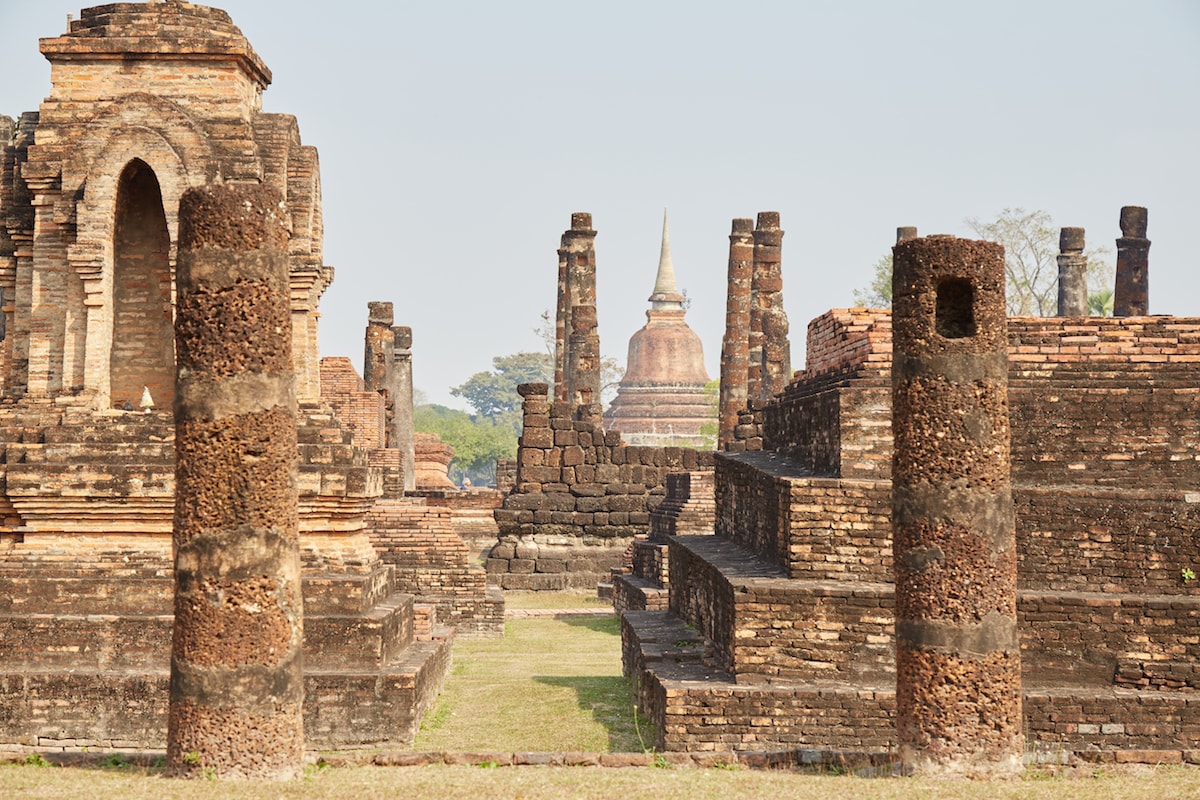
The temple’s central chedi was constructed in a traditional Sukhothai lotus-bud shape by the kingdom’s very first ruler, Si Inthrathit. Successive rulers continued to add their contributions to Wat Mahathat, bringing the total to around 200 chedis by the time of Sukhothai’s abandonment!
In addition to the local Sukhothai style, the temple features architectural elements from many other kingdoms which Sukhothai had relations with over the years. Walking around the complex, you’ll find chedis in the Haripunchai (Lamphun), Khmer and Lanna styles.
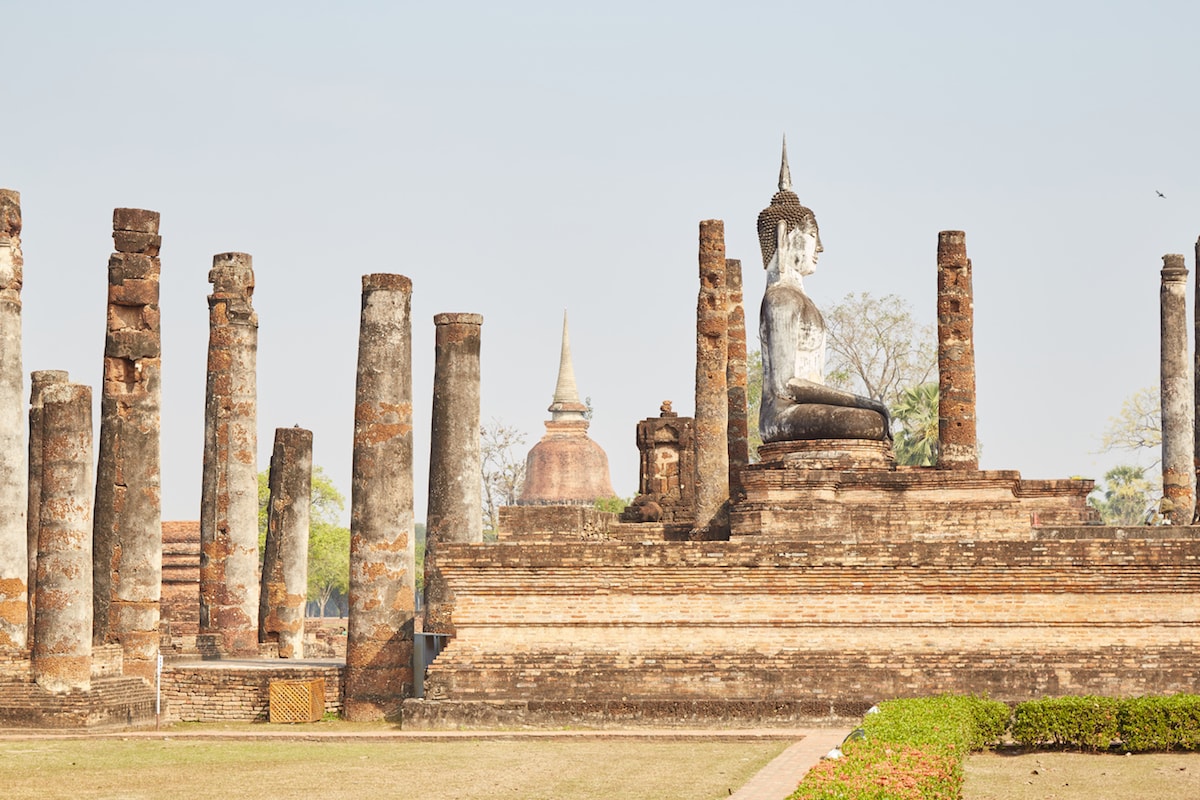
Along with stone, Wat Mahathat also contained a number of wooden structures, none of which still survive, of course. You can still see the tall columns of the original viharn which had been built on top of a raised platform. The original bronze Buddha image kept here can now be found at Bangkok’s Wat Suthat.
Other structures around the temple include an ubosot, or ordination hall, and mondops, one of which holds a 12-meter tall standing Buddha.


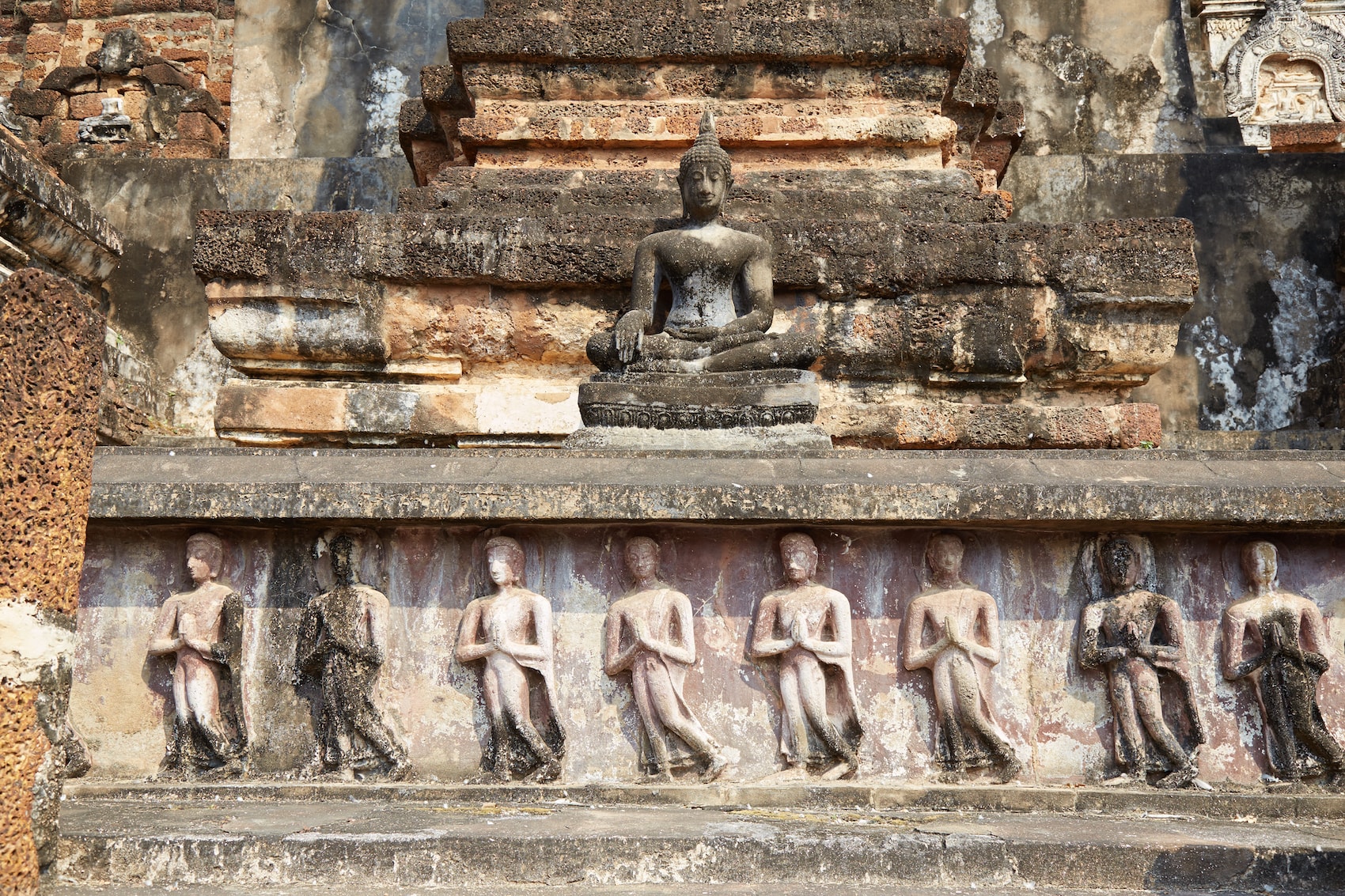
Wat Si Sawai

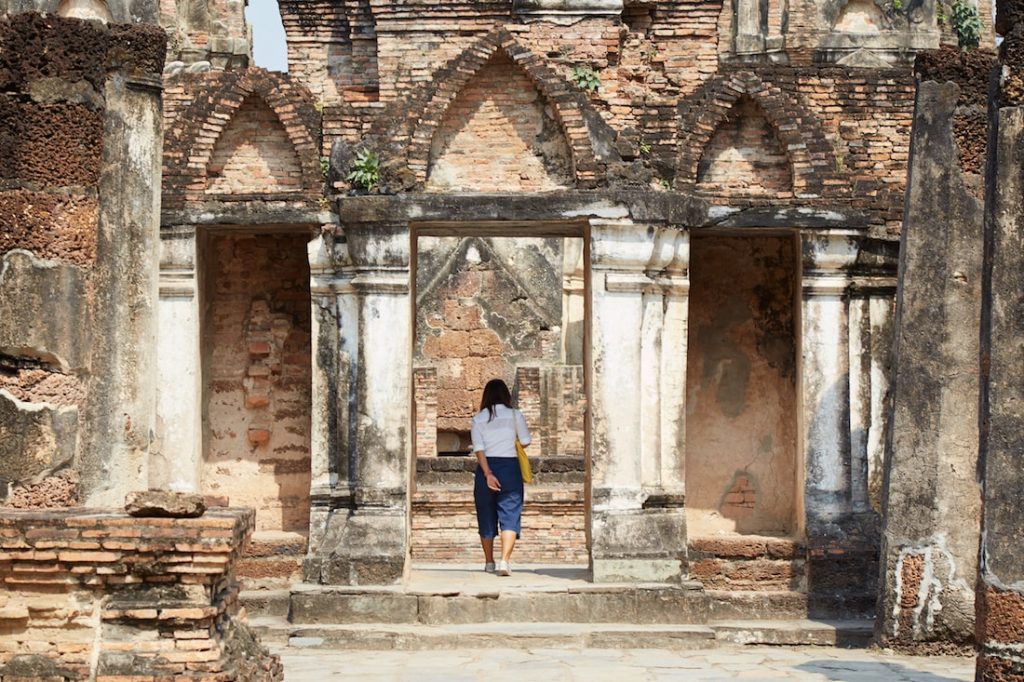

Wat Si Sawai, in the southern part of the Royal City, is noticeably distinct from the other temples in the area. The temple features three large prangs in the traditional Khmer style. This temple was, in fact, built by the Khmer Empire before Sukhothai became an independent kingdom.
Probably built in the late 12th century, the central laterite prang is dedicated to Shiva, the temple’s main deity. The other two prangs represent the other main gods of the Hindu trinity, Brahma and Vishnu.




An image of Shiva was found at the site, while Shiva lingas can still be seen today. Looking closer at the prangs, you’ll find depictions of mythological beings like nagas and makharas as well as Hindu priests.
Mysteriously, the prangs were left unfinished. They were finally completed a couple hundred years later in the 15th century. And also at some point, the temple had been converted from a Hindu one to a Buddhist wat, evidenced by the walls of the large viharn which remain standing.
Wat Sa Si
Wat Sa Si is situated on a small island within an artificial lake, and can only be accessed by walking across a narrow wooden bridge. Once on the other side, you’ll find the ruins of a viharn in front of a large Singhalese (Sri Lankan) style chedi. The bell-shaped chedi was originally built to enshrine the ashes of a former king.
There was even a small ubosot on its own little island to the east of the main temple, though that area was undergoing some kind of construction during my visit.
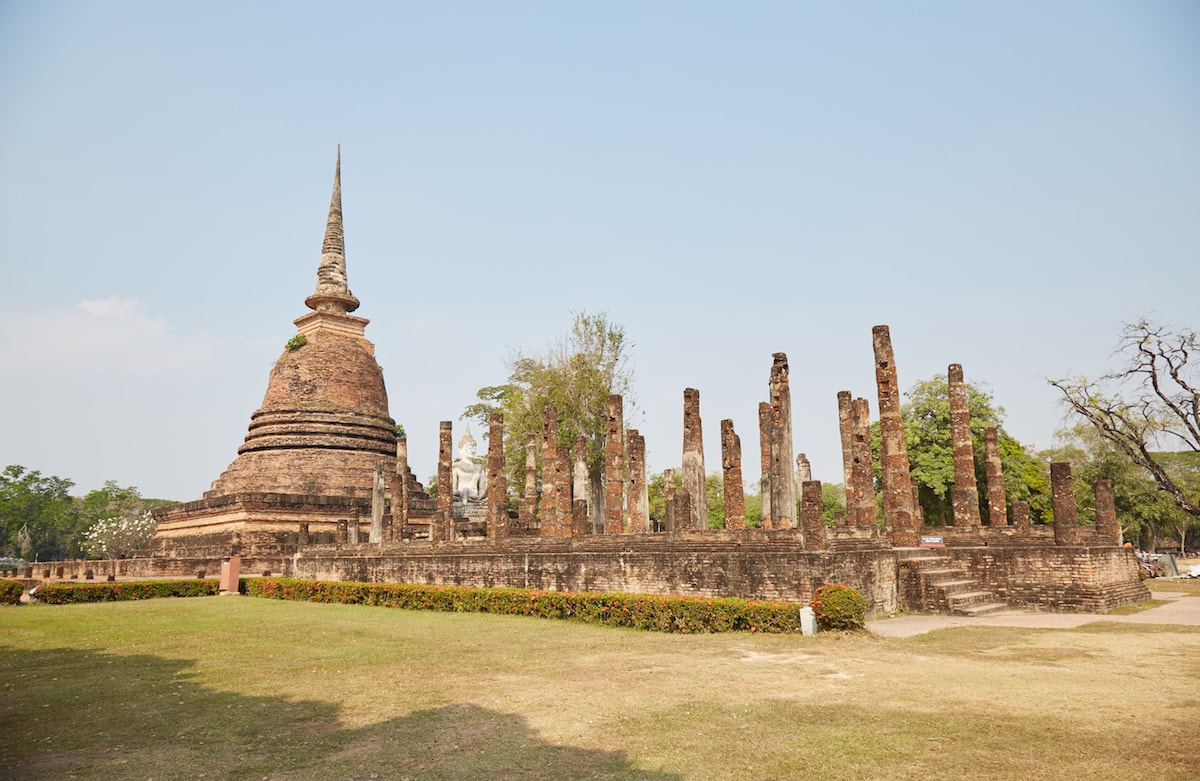

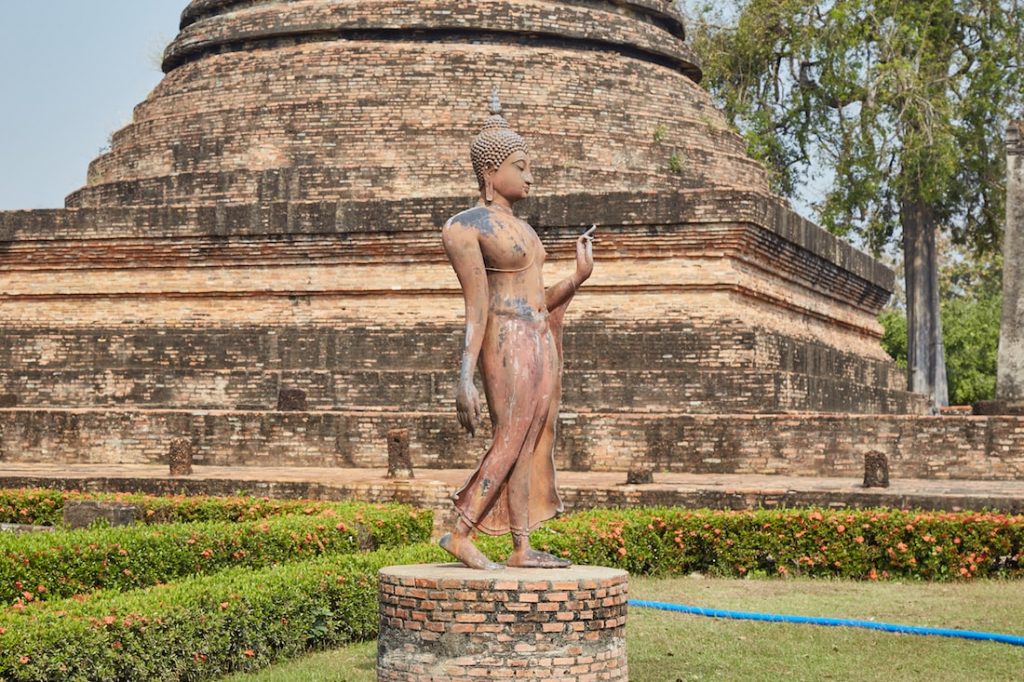
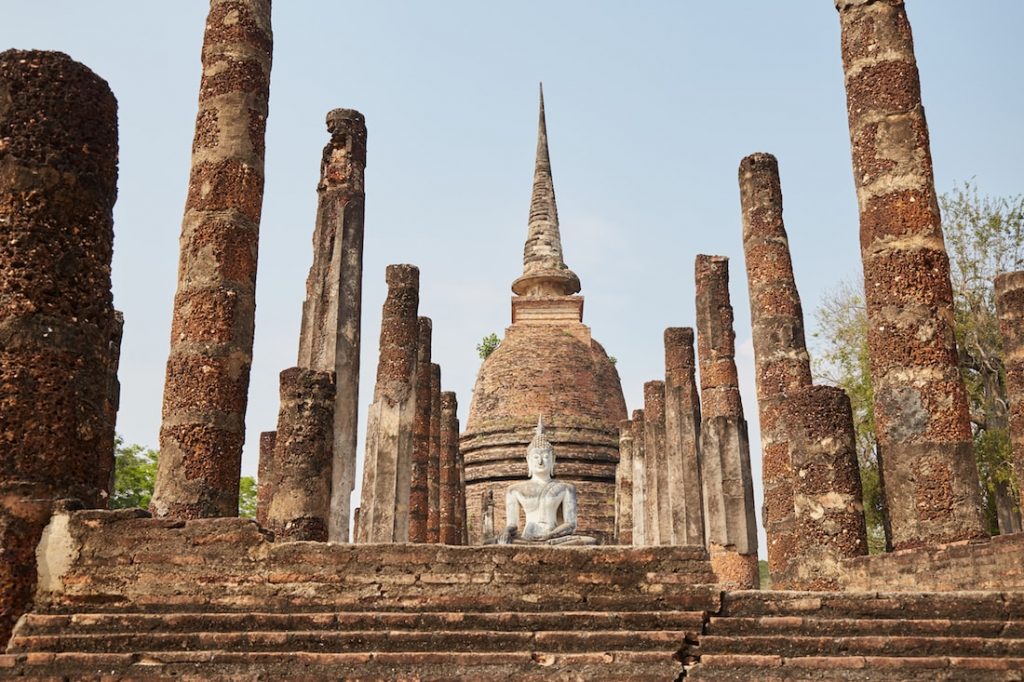
Wat Traphang Ngoen
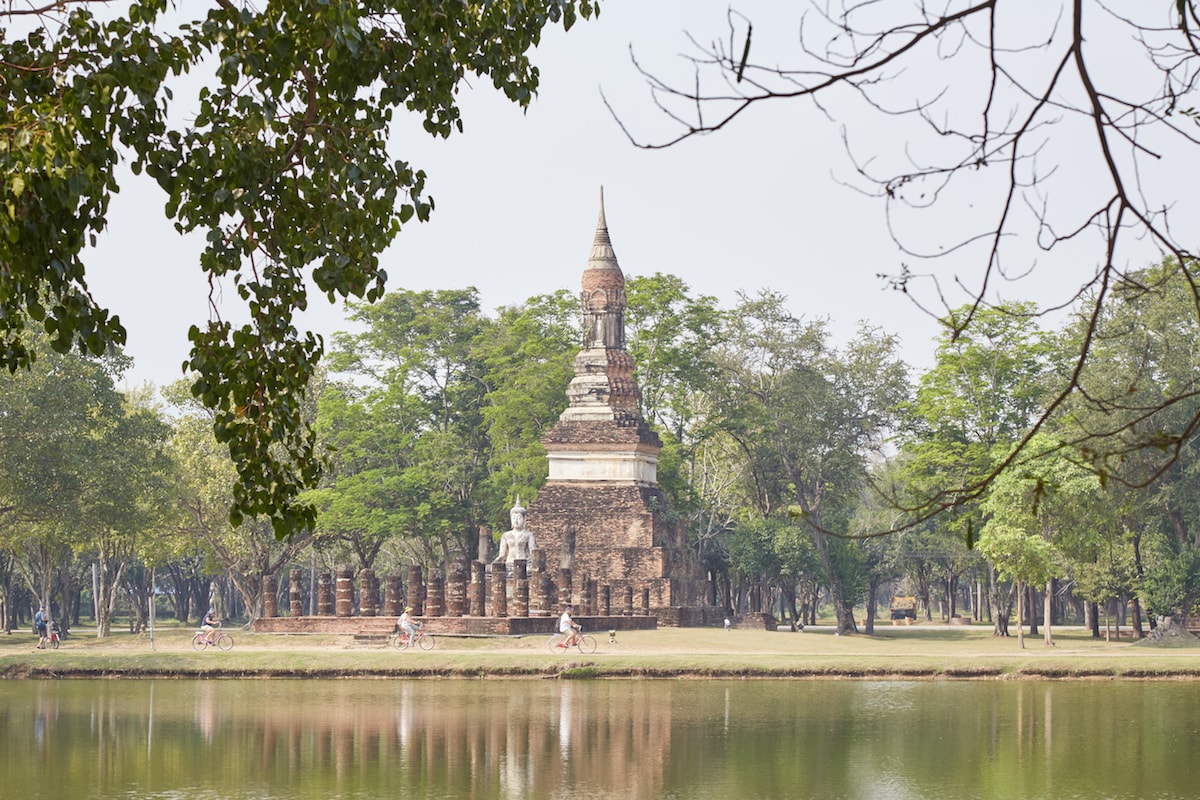
Across the water from Wat Sa Si, you’ll notice Wat Traphang Ngoen and its tall lotus-bus-shaped chedi. Similar in style to the central spire of Wat Mahathat, this temple is believed to have been constructed around the same time. Walking over to the temple, you’ll be greeted by great views of Wat Mahathat across the lake. Also somewhat close by is a cafe, should you want to stop for lunch or coffee without having to go back into the city.
Wat Mai
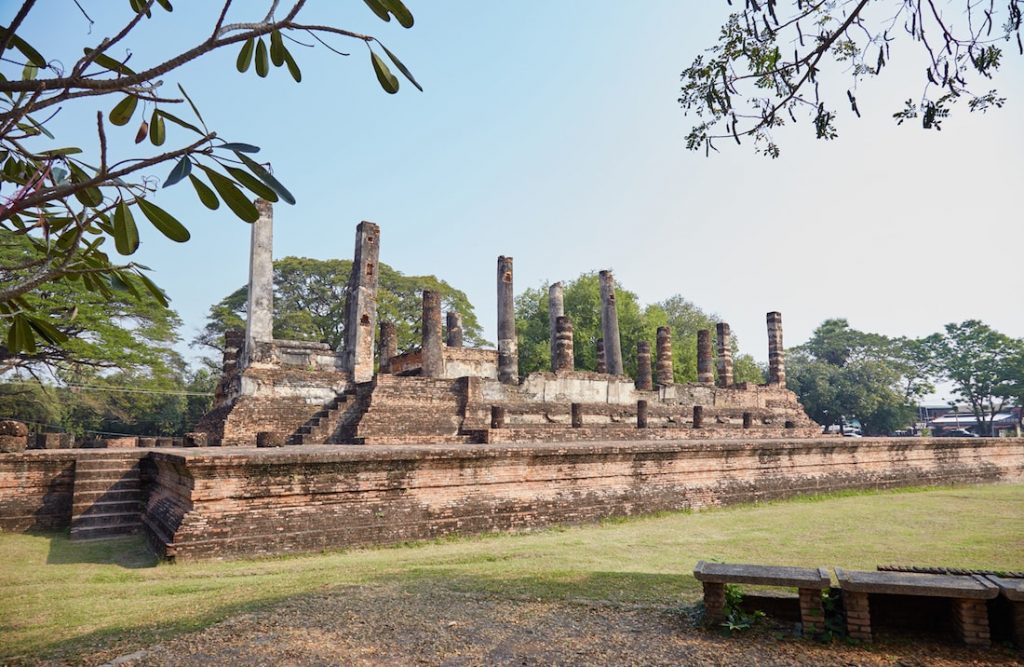
Wat Chana Songkhram

King Ram khamhaeng Monument

The North Zone
Heading out the northern gate of the central zone, you’ll encounter a number of impressive temples even before you reach the official ‘North Zone’ of the Historical Park. They exist in sort of a zoneless no man’s land, making them always free to visit. As you’ll later discover, this is just one of many areas in Sukhothai that you can access for free.
Ta Pha Daeng Shrine

Wat Mae Chon
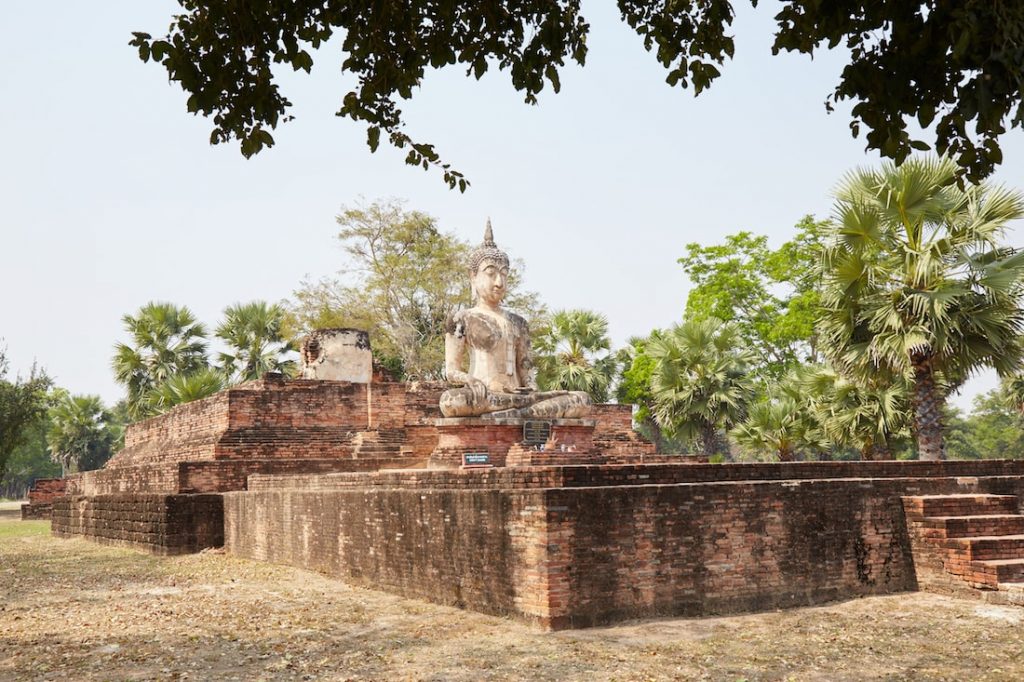
Wat Sorasak
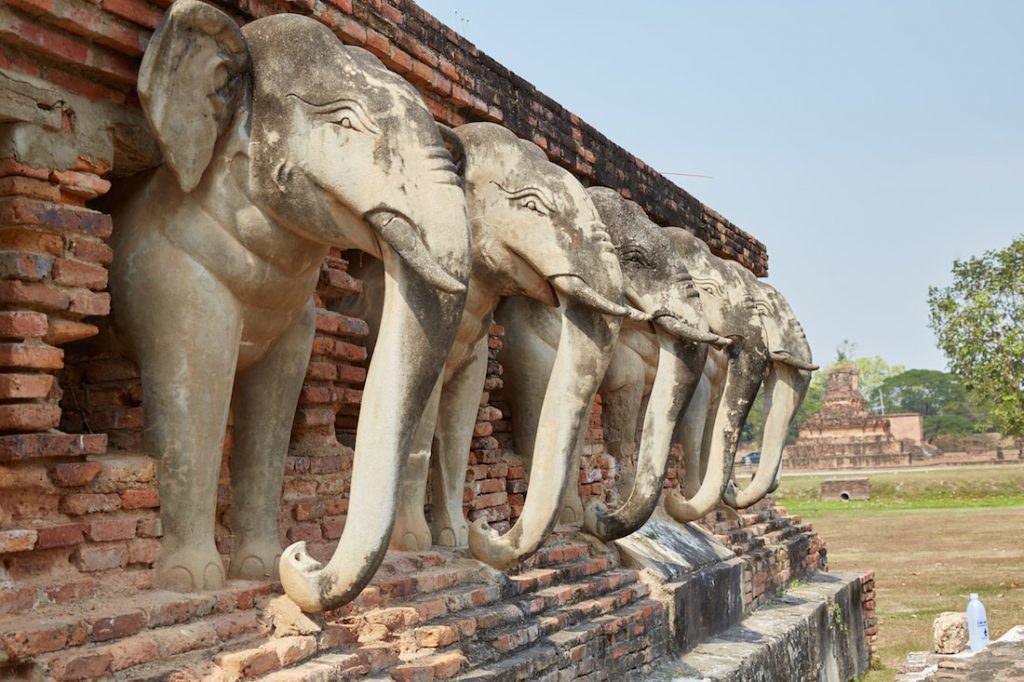
The 14th century Wat Sorasak features a large bell-shaped chedi made of brick, which is flanked by a series of 24 stucco elephant figures
If you’re not in a rush, there are even more temples to explore in this free area, including Wat Traphang Pan and Wat Traphang So. The latter can be found on its own little island, though not much remains of the temple itself. When finished, it’s time to head to Wat Phra Pai Luang which requires a ‘North Zone’ 100 baht ticket.
Wat Phra Pai Luang
Like Wat Si Sawai, Wat Phra Pai Luang is another Khmer structure dated back to the region’s time as a Khmer outpost. In fact, this one may be as old as the reign of Jayavarman VII, the builder of great Angkor temples like the Bayon, Preah Khan and many more. Though the Khmer Empire was largely Buddhist at the time, this temple is believed to have been dedicated to Vishnu. Later on, it was converted to a Theravada Buddhist temple.



Wat Phra Pai Luang is much larger than Wat Si Sawai, and the whole complex is surrounded by a large moat. You’ll need to cross a bridge on your bike to get there. Before the construction of the Royal City, Wat Phra Pai Luang may have been the heart of what was considered Sukhothai back then.
Of the three Khmer style prangs, only one still remains. Behind it is the large base of the former viharn, which is also mostly in ruin. You’ll also notice some other chedis, such as the stepped tower built in the style of the ancient kingdom of Haripunchai. As the temple remained in use up until Sukhothai’s abandonment, the temple ruins also feature Ayutthayan architectural elements as well.
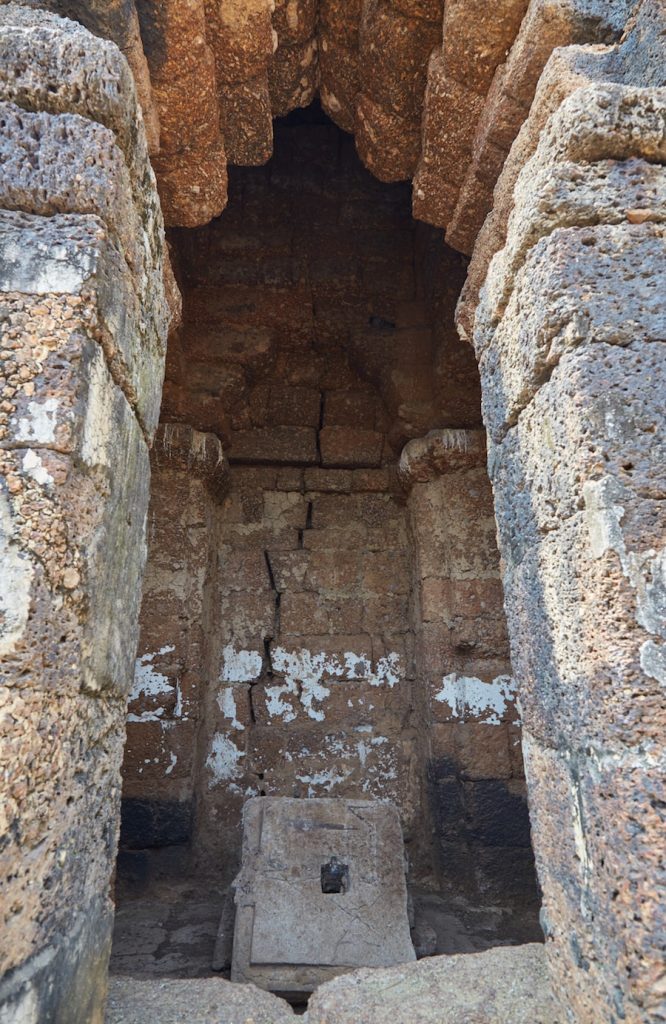


Somewhat confusingly, there is also a modern temple of the same name on the island together with the ruins. Inside you’ll find some attractive golden Buddha images. Also around the area are some ancient kilns, situated just north of the moat.

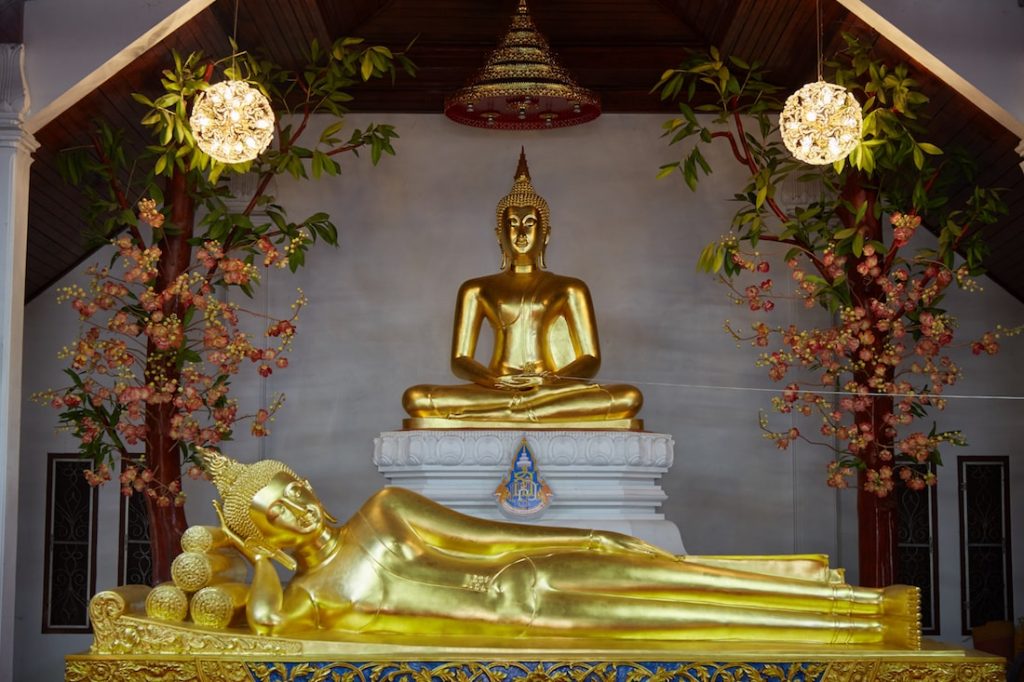

Wat Si Chum
Wat Si Chum is located some distance from Wat Phra Pai Luang, though it’s still considered part of the North Zone. In fact, you’ll need to show your ticket again to enter. The ride over, however, is absolutely worth it, as Wat Si Chum is one of the most awe-inspiring landmarks in all of Sukhothai.



Inside the temple’s mondop is the gigantic Phra Si Achana Buddha image, which is 15 meters high and 11 meters wide. The statue, made of brick and stucco, was restored in the 1950’s.
The Buddha image is also the subject of an interesting 16th-century legend. As Sukhothai was the site of battles between Burma and Ayutthaya in the late 1500’s, King Naresuan once ordered a soldier to give a speech from atop the Phra Si Achana Buddha. At the time, the mondop had a roof. The acoustics were so good, apparently, that many of the soldiers were convinced the statue itself was speaking!
Next to the main mondop, you can find a smaller mondop with another seated Buddha image popping out of the top. Nearby, there’s also a more modern temple that’s home to dozens of smaller Buddha images. It might be worth checking out to escape the midday heat.
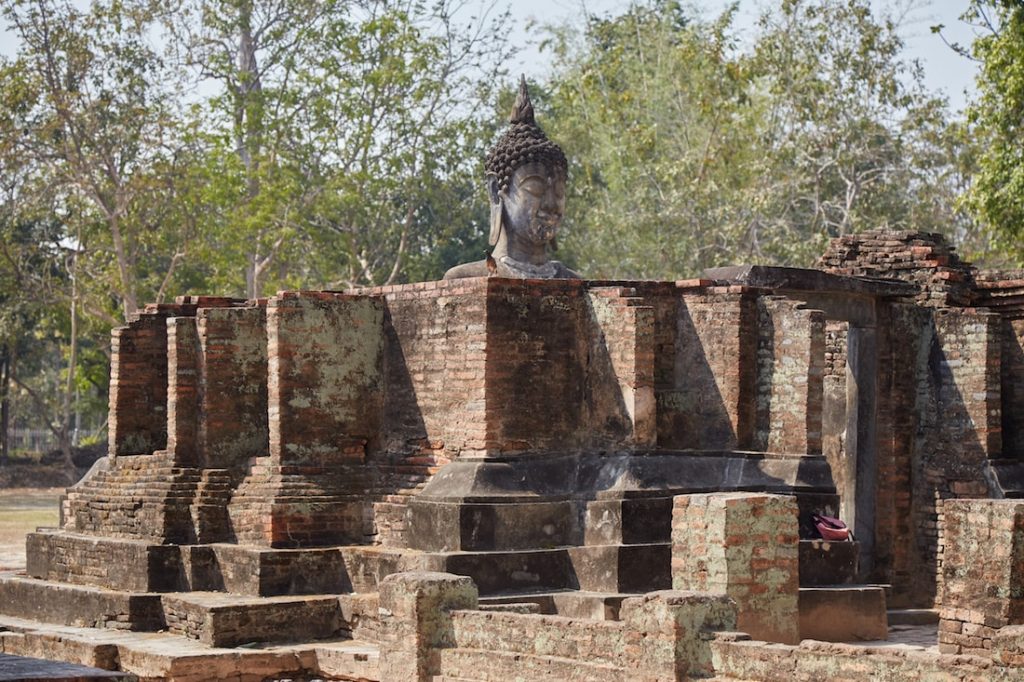
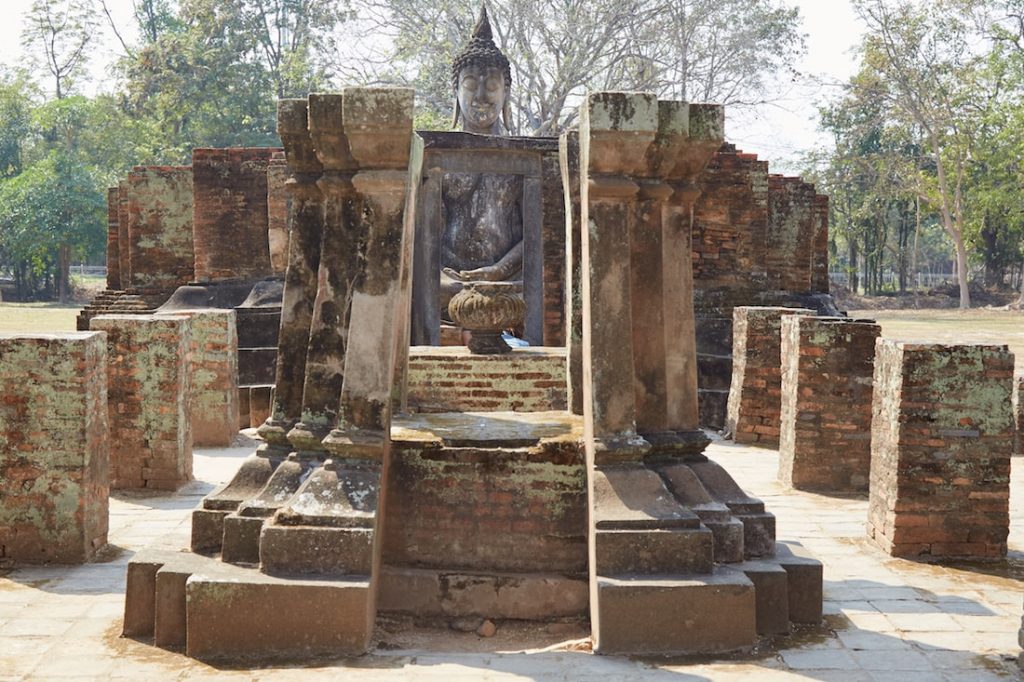

Within the large mondop is a hidden staircase containing 14th-century slabs depicting scenes from the Jataka tales, or past lives of the Buddha. While the staircase has been closed to visitors, the slabs have been moved to the Sukhothai National Museum (more below). In fact, they’ve also been placed along a staircase within the museum to help recreate the experience.
The West Zone
Overall, the West Zone is not nearly as impressive as the Center and North Zones, but it does contain one notable temple. Though you will need to pay to visit Wat Saphan Hin, there’s also a largely unknown free cluster of temples to the south of the ticketed area, or just directly west of the Center Zone.
Wat Saphan Hin
Wat Saphan Hin is the only major Sukhothai temple situated on top of a hill. The temple was even mentioned in the King Ram Kamhaeng inscription. The climb up is a relatively easy one, but be careful along the rocky path.
At the top, you’ll find a large 12.5 meter high standing Buddha image. Supposedly, the King Ram Khamhaeng would ride a white elephant here for worship on the Buddhist sabbath.
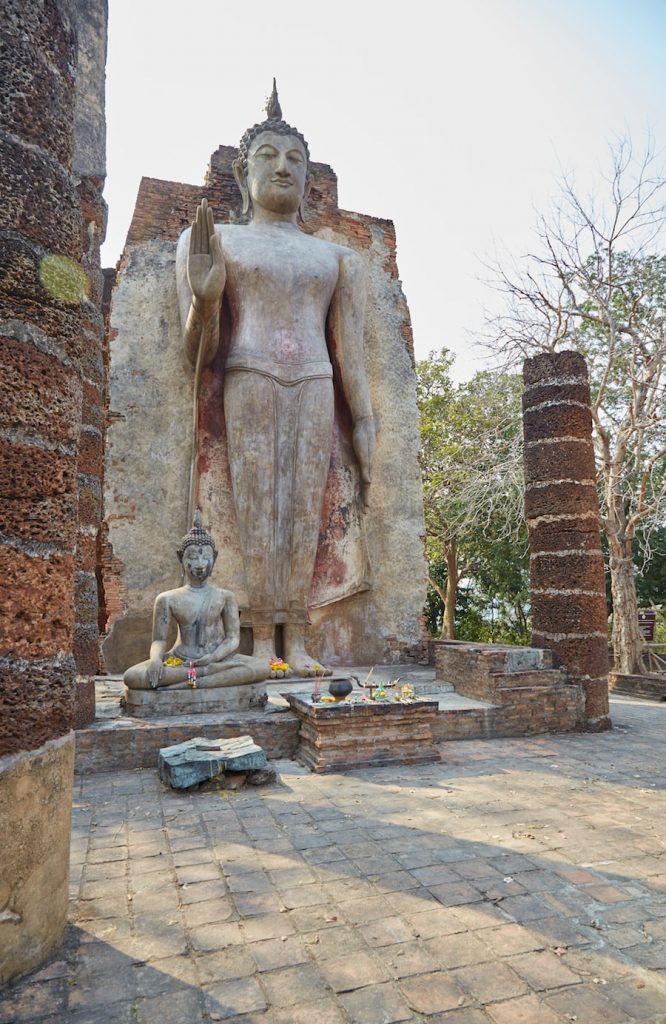
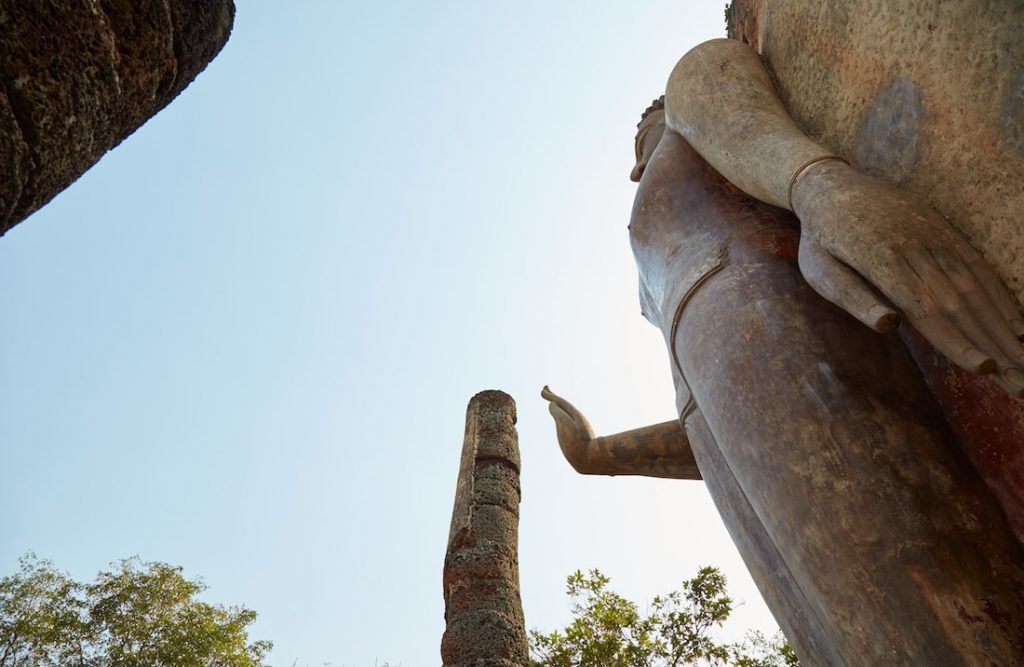
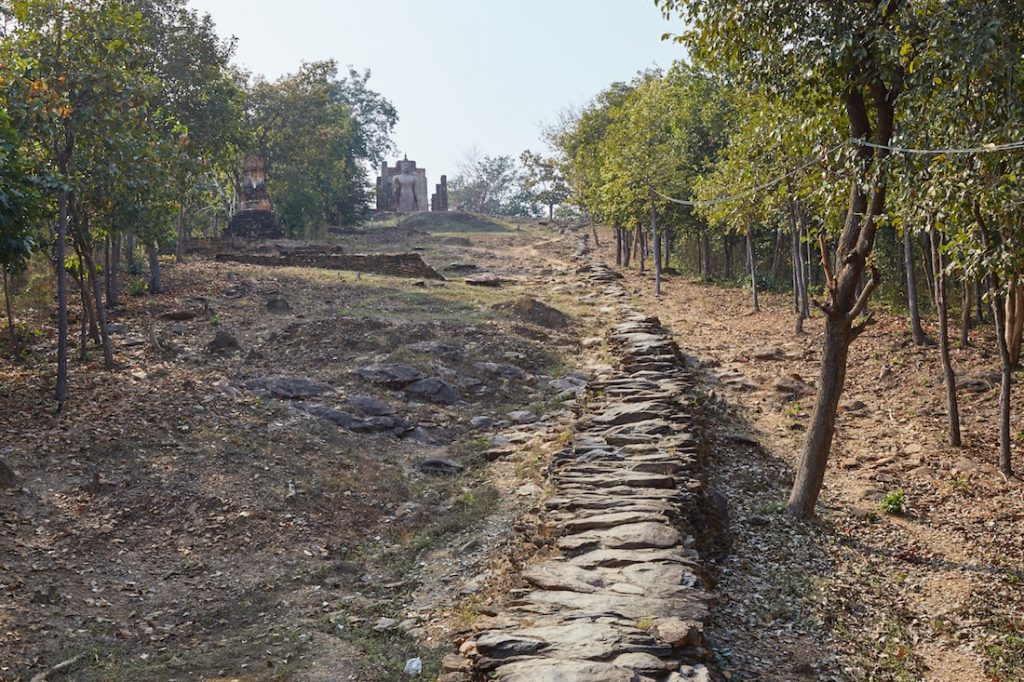

Aside from the standing Buddha, there’s not a whole lot to see other than the view of the rural surroundings. The view faces east, so this isn’t an ideal sunset spot, either. If you happen to be staying in Old Sukhothai, Wat Saphan Hin would be perfect for catching the sunrise, though it’s unclear if the temple would even be accessible that early.
Forest Temples
Heading further west, you’ll reach a cluster of forest temples. According to the Ram Khamhaeng inscription, a very learned monk from Nakhon Si Thammarat lived in the area. While the temples individually aren’t as impressive as what you’ll find in other zones, the region as a whole is fun to explore. It’s very similar to the Aranyik area of nearby Kamphaeng Phet Historical Park.
Ho Thewalai Mahakaset
Southeast of Wat Saphan Hin, and outside of the ticketed West Zone area, is a unique square temple called Ho Thewalai Mahakaset. The temple dates back to the 14th century and was made for Brahmin priests to worship Hindu deities at. Two impressive bronze statues found here are now on display at the Sukhothai National Museum.

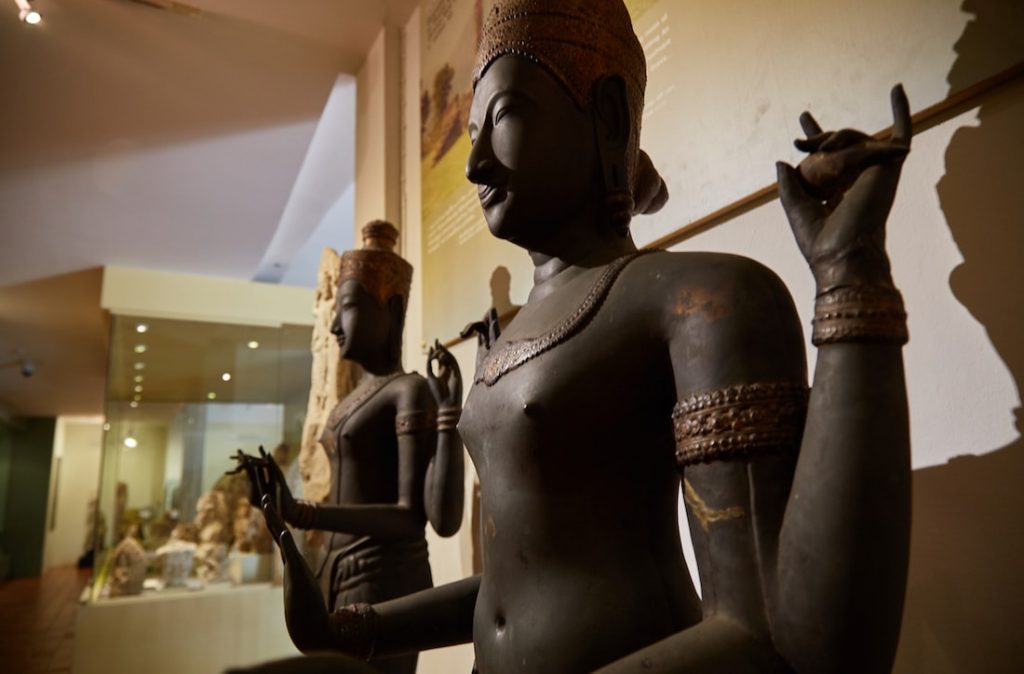
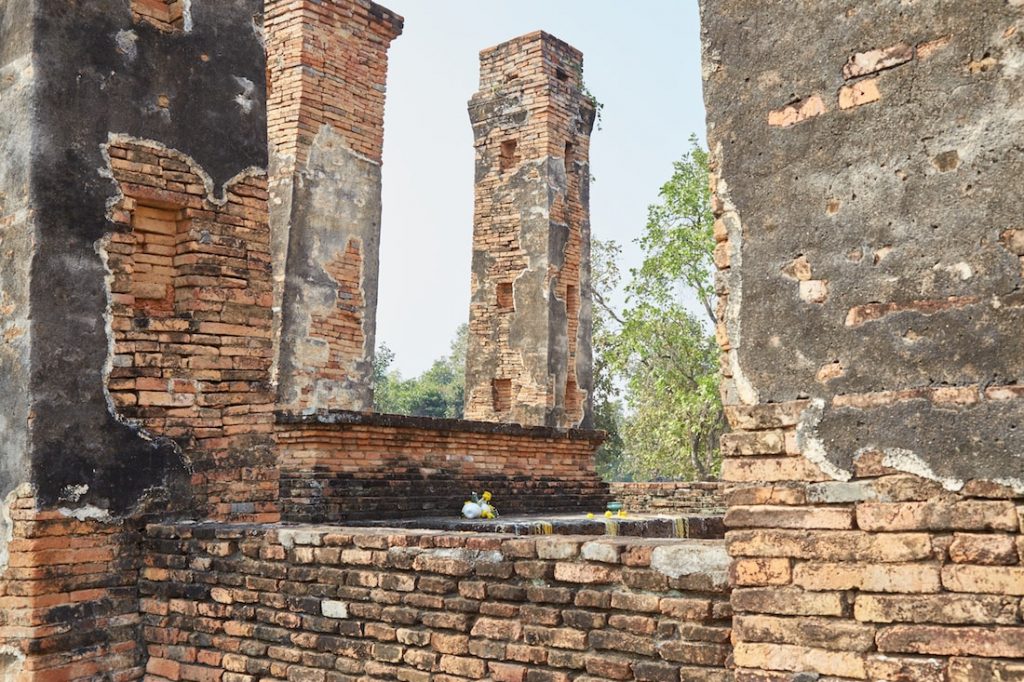
Despite what I considered to be pretty thorough advanced research, this temple never showed up in any of the reading I’d done prior to my trip. It wasn’t until I got to the museum that I noticed the ornate multi-armed bronze Shiva and Vishnu statues on display. They were labelled as coming from this temple, which was only about 10 – 15 minutes away by bicycle.
Ho Thewalai Mahakaset is probably more interesting after having seen the statues in the museum, so you may want to save it for later in your trip. Luckily, it’s far from being the only temple in the area. There are several other temples nearby to explore in yet another free zoneless part of town. Another bonus is the complete lack of other tourists and gorgeous scenery.
The South Zone
The area once cost money to access, but as far as I could tell, the sole ticket booth was shuttered up and vacant during my visit. The southern area may not contain the astonishing architecture of other regions, but it’s one of the most enjoyable parts of Sukhothai to cycle through.
If you’re into cycling through peaceful rural backroads while coming across a plethora of small hidden gems, you may want to consider adding a second day to your Sukhothai itinerary and make the journey south.
Wat Chetuphon
Wart Chetuphon is the largest temple in the southern area. Similar to Wat Phra Si Ariyabot in neighboring Kamphaeng Phet, the temple features a mondop with four different large Buddha poses – walking, standing, sitting and reclining. Only the walking pose can be made out clearly, and even that one’s headless.
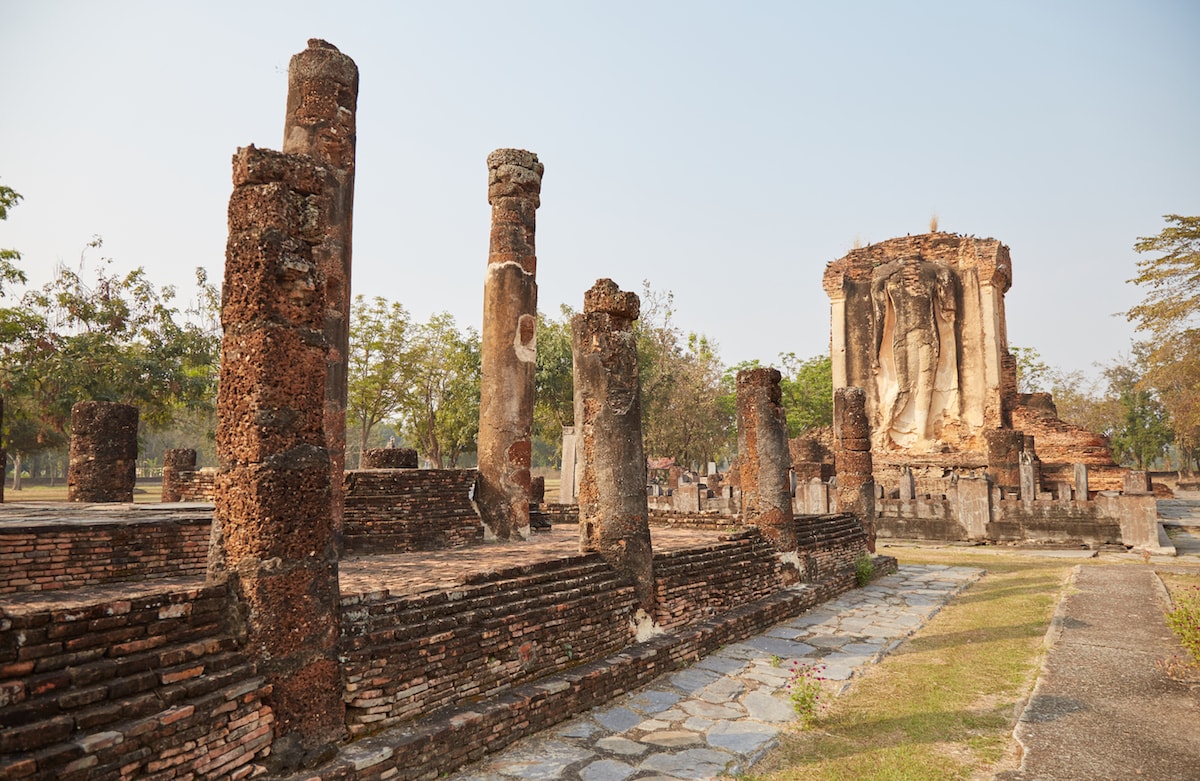
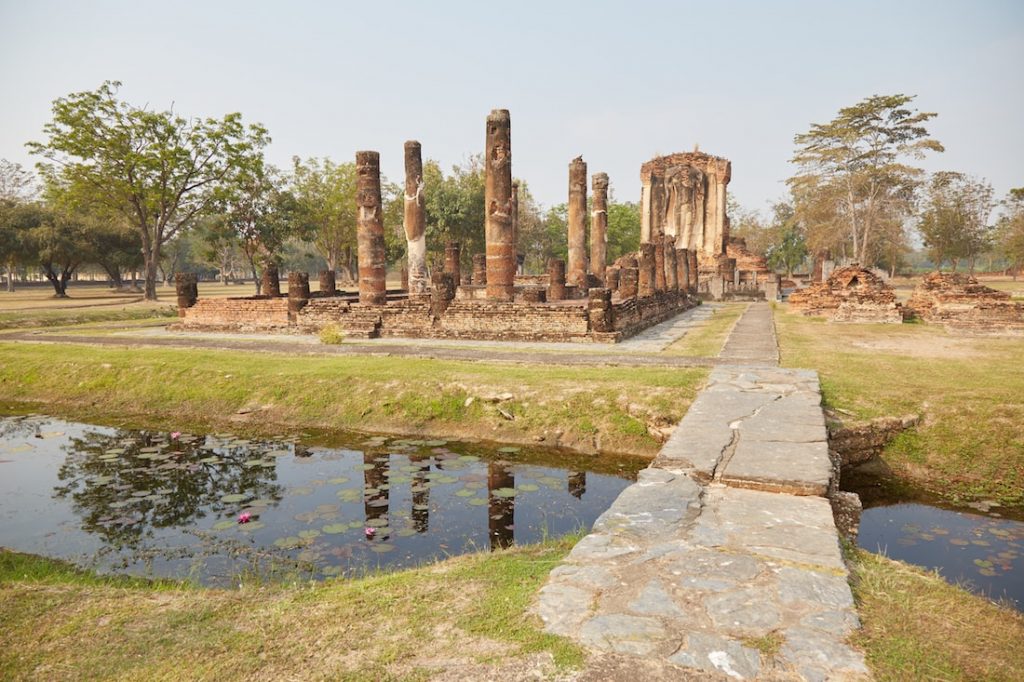

Estimated to be from the beginning of the 16th century, the temple was clearly an important structure in its day. It features a moat, large viharn and spacious courtyard. Noticeably missing, though is a chedi. You can, however, find a large one at the temple just across the street.
Wat Chedi Si Hon
As the name suggests, the highlight of Wat Chedi Son is its large chedi. Around the base you’ll notice stucco images of lions and elephants, along with some four-armed divinities. It’s believed that some of them actually depict an underworld deity called ‘Manysayanga,’ popular in Sri Lankan lore. Elsewhere you can find a second smaller chedi and the ruins of the viharn.
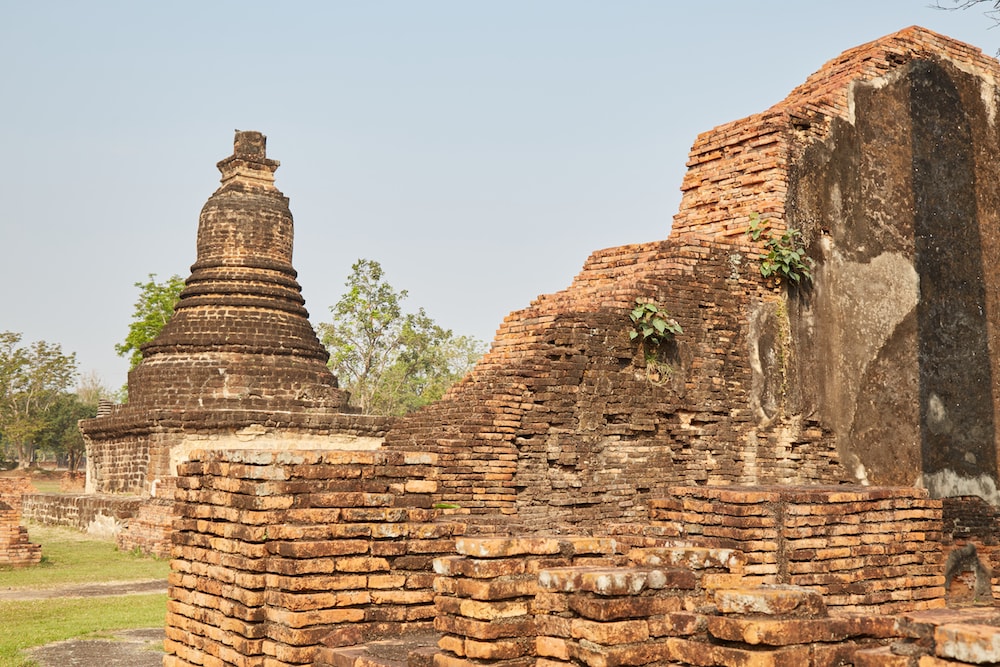

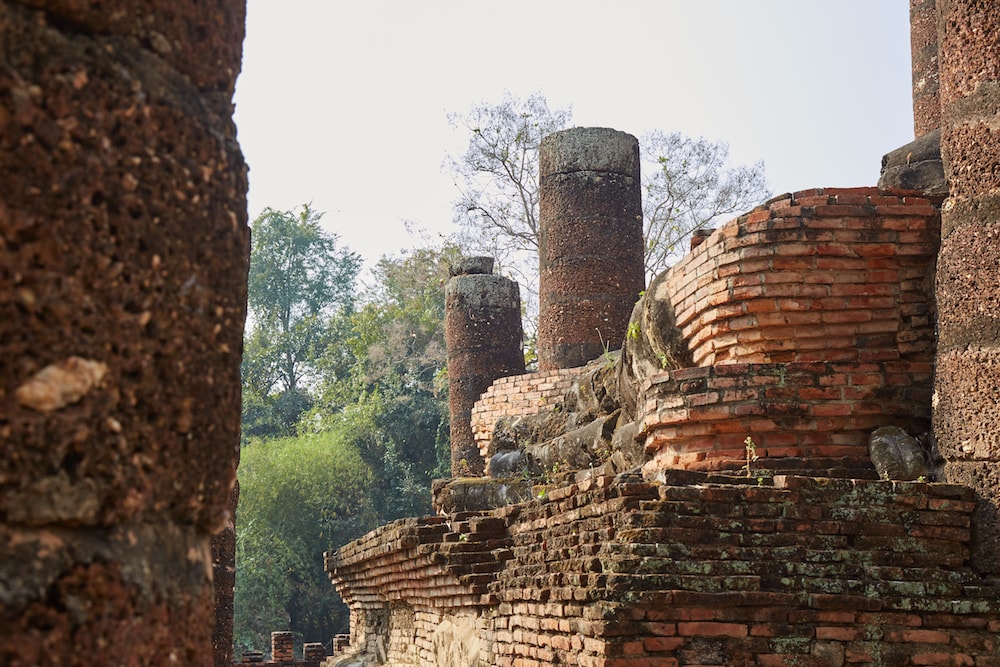
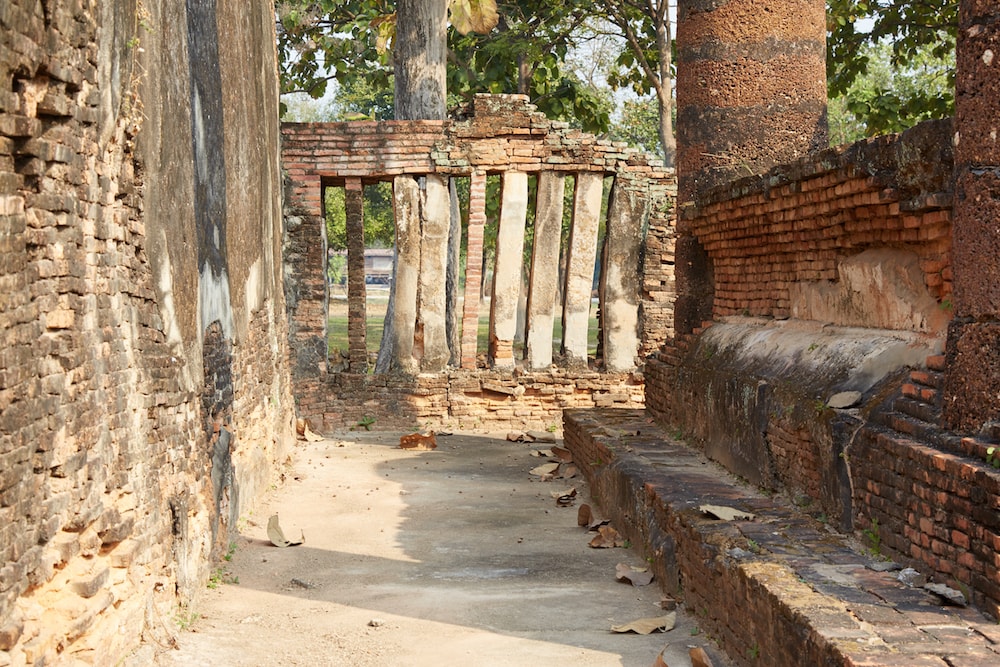
Wat Si Pichit Kir Ati Kanlayaram

Wat Si Pichit Kir Ati Kanlayaram features a chedi as tall as the temple’s name is long. This is another Singhalese bell-shaped chedi, though unlike similar chedis, it was built on top of a large brick base. Supposedly, it was built in the year 1400 under the supervision of a monk from Kamphaeng Phet.



Wat Asokaram

Wat Kon Laeng

Wat Mum Lanka
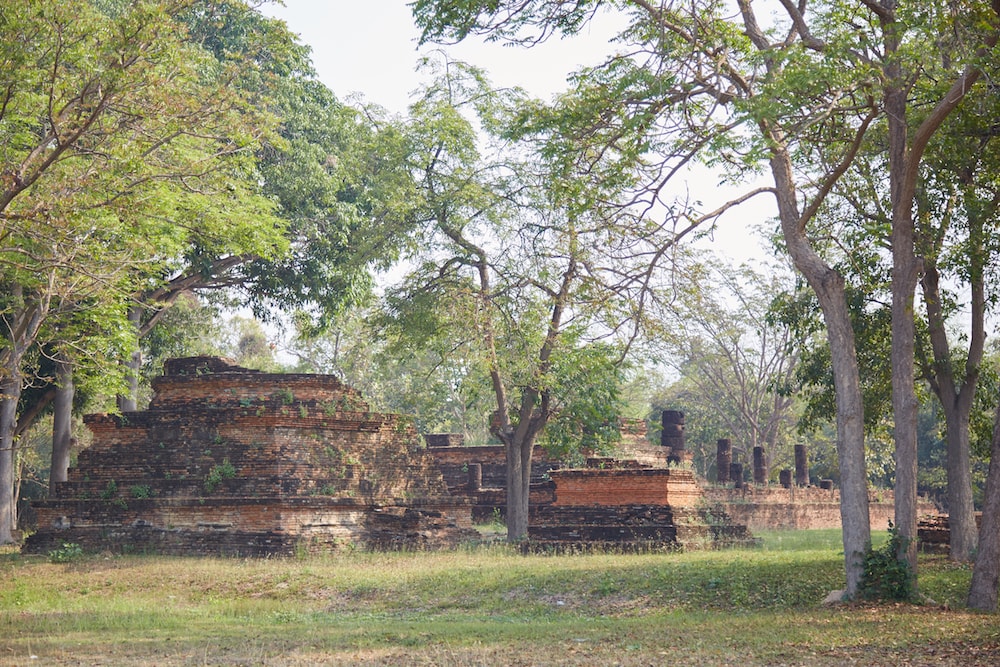
Wat Wihan Thong

As mentioned, most of the fun of riding around the southern area is coming across ruins here and there by surprise, such as the ones pictured above. As you head back north to the center of town, use the smaller road that’s adjacent to highway 1272. You’ll find lots of temples on either side of this road here. Eventually, the road merges with 1272 and soon you’ll be near the East Zone.
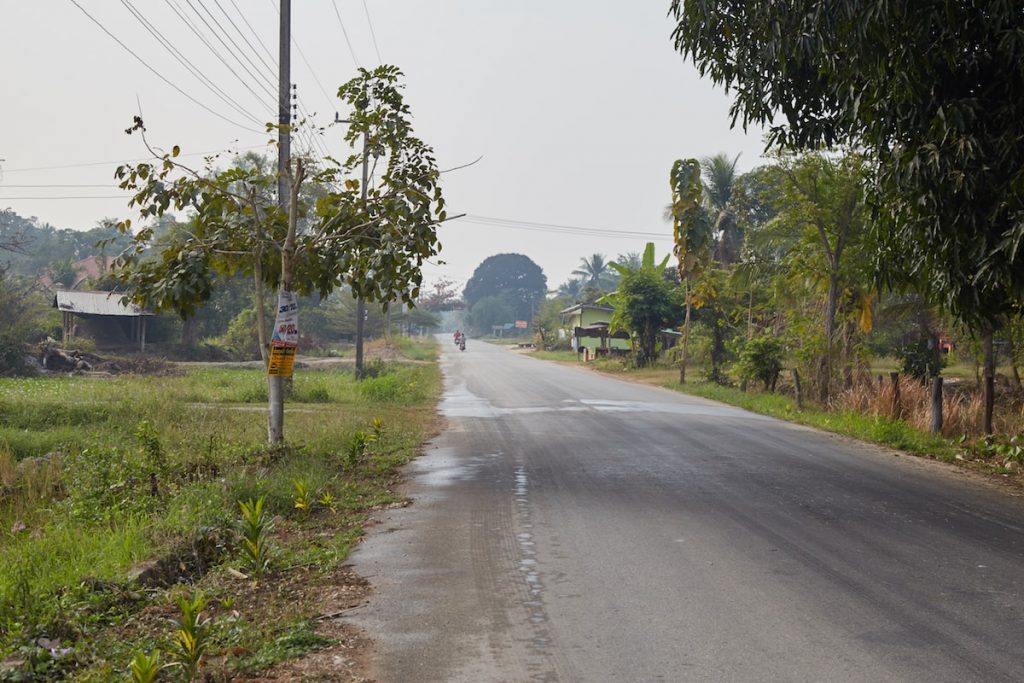
The East Zone
Like the South Zone, the East Zone is also free, with no ticket checkers in sight (as far as I could tell). Some of the sites we’ll be going over in this section are right by the entrance to the Center Zone, though since they’re just to the east of the ticketed area, they’re included here. Like the South Zone, the real highlight here is riding around and enjoying the scenery as you explore smaller temples along the way.
Wat chang Lom

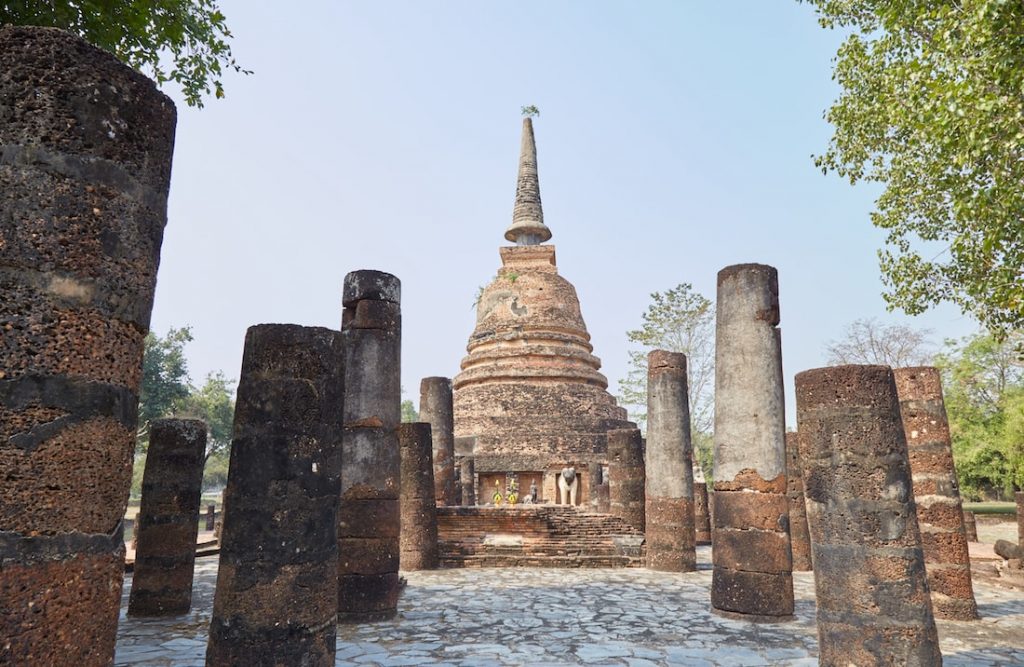
The main temple in the eastern area is Wat Chang Lom – a large stupa surrounded by elephant figures at the base. If you’ve already visited most of the temple in Sukhothai, this is hardly anything new.
Perhaps more interesting than the temple itself is the fact that it’s along a special bike lane path which goes all the way to the bus station. I decided to explore the path to see what I could find. While I didn’t come across much as far as temples go, the scenery consists of vibrant green rice paddies with mountains in the distance. You’ll also pass by a number of local residences, getting a good feel for local life in rural Sukhothai.

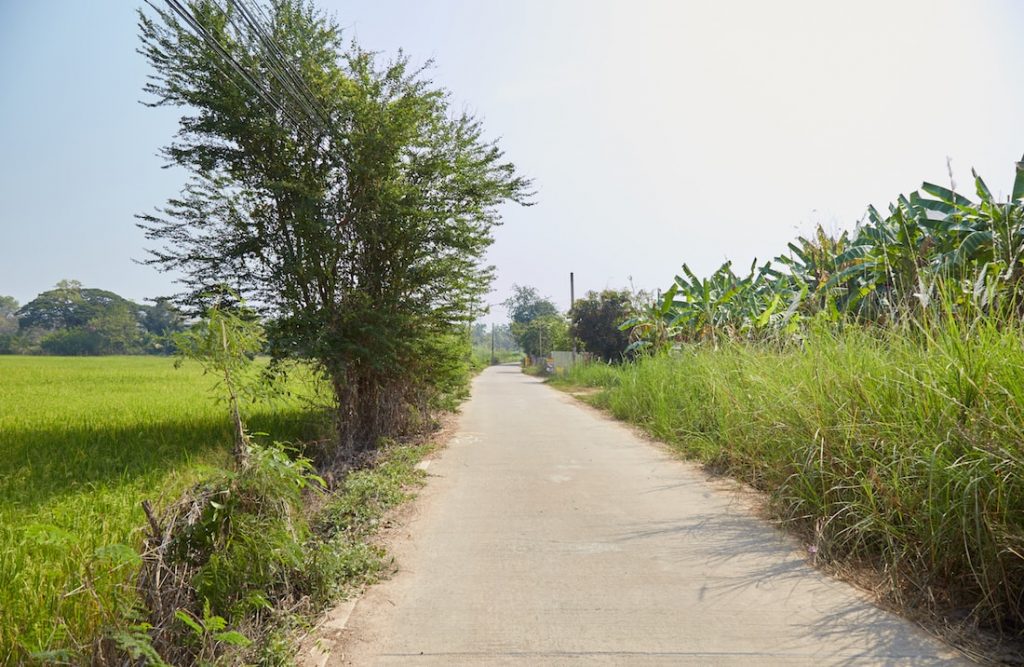
With no traffic on the designated path, it’s a real pleasure to bike through. Assuming you don’t want to bike all the way to the bus station just yet, a good place to end your journey would be a small family-owned gallery, simply referred to as the ‘Sukhothai Folk Museum.’
From Wat Chang Lom, head east down the bike path for about 15 minutes until you reach highway 1272. Turn left (north) and just after a minute you should find the museum on your left. The museum contains a collection of old artifacts and the friendly owner speaks decent English. While free, there’s also a gift shop attached which sells a special type of stone sourced only in Sukhothai (or so they say). In any case, the jewelry or Buddha and Ganesha figurines here are much more reasonably priced than what you’d find at the night markets in Chiang Mai, for example.

Wat Chedi Sung
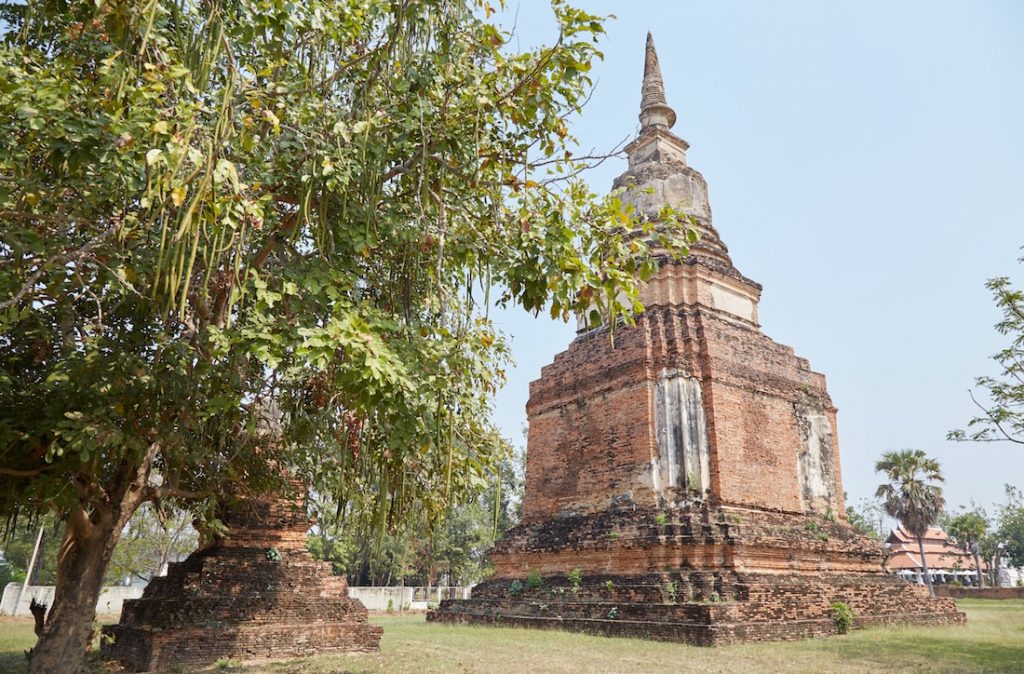
Heading back west toward the Center Zone entrance, you’ll find Wat Chedi Sung on your left (south side of the main road). This is considered to be one of the older chedis in the region, and the structure is noticeable from quite a distance.
If you have yet to visit Wat Traphang Thom and the National Museum, continue heading west until you get to the main part of Old Sukhothai. This would also be the ideal place and time to grab some lunch.

Wat Traphang Thong
Wat Traphang Thong combines old ruins with a modern, living temple. The temple was constructed on an island in the middle of an artificial reservoir, perhaps a design adopted from the Khmer. The real highlight here is the long wooden bridge and the view of the water it provides.

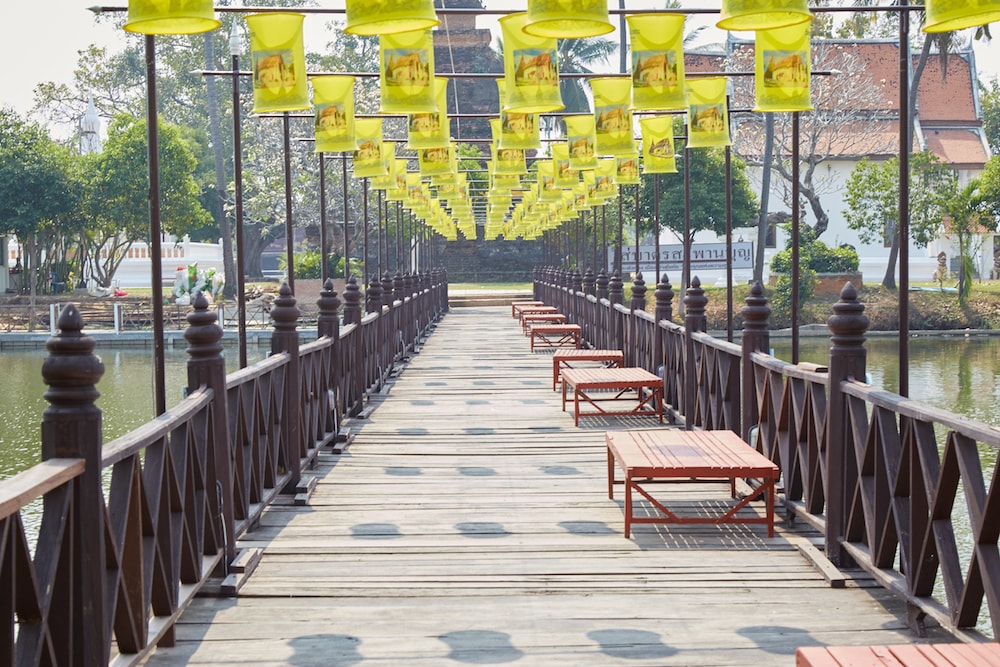


The Sukhothai National Museum
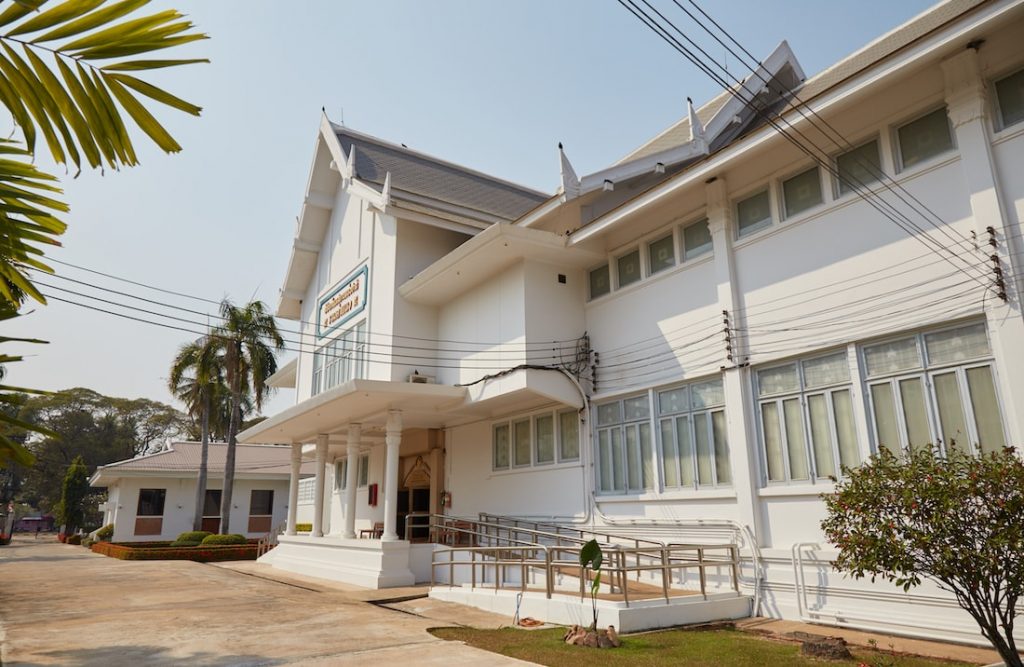

Some might prefer to visit the Sukhothai National Museum first, which is easy to do considering it’s right near where the shuttle drops people off. I personally prefer to visit museums closer to the end of my explorations. In any case, this would be a convenient place to either start or end your day, as it’s also close by the bicycle rental shops.
In addition to artifacts found around the area and information about Sukhothai’s history, you’ll also find a lot of information about King Ram Kamhaeng and his inscription. Unfortunately, the one kept here (pictured below) is not actually the real one. To find the original, you’ll have to go visit the Bangkok National Museum.
As the inscription is believed to be the first example of Thai script, the museum also contains a lot of information about the Thai written language, and how it evolved out of similar Khmer and Mon scripts. The inscription, which detailed King Ram Kamhaeng’s life in addition to the history of important Sukhothai landmarks, is not without its controversy, however.
The tablet was discovered by King Mongkut (Rama IV) in 1833 (about 20 years before he was ordained as king) at Wat Mahathat. To this day, however, there is still heated debate among scholars as to whether the inscription is real or a forgery.
Whatever the case may be, there’s no denying that it’s greatly influenced Thai cultural and national identity since its emergence in the 19th century. To this day, Sukhothai is still credited as being the birthplace of Siamese culture, as well as the first national capital of what would eventually become modern-day Thailand.
Additional Info
The most straightforward way to get to Sukhothai would be by bus. You can find direct buses from either Chiang Mai or Bangkok, with either route taking several hours.
Coming from nearby towns like Kamphaeng Phet or Phitsanulok only takes an hour by bus.
By train, your only option is to ride to Phitsanulok and then transfer to a bus. The bus station is an easy taxi ride from the train station there. This method takes longer than the long distance bus, as the train ride alone from either Chiang Mai or Bangkok lasts around 7 hours.
Sukhothai also has a small airport, though it’s only served by Bangkok Airways via Suvarnabhumi Airport. If you can’t stand long bus rides and are already in Bangkok, this option might be worth looking into. Another option would be to fly to Phitsanulok and then take a shuttle to Sukhothai.
The ruins of Sukhothai are outside the city itself, but there’s luckily a great system in place. From the bus station or from various points in the New city, you can grab a shared songthaew which regularly travels in between the city and the Center Zone of the Historical Park. A ride costs 30 baht one way.
And just when you get off, you’ll encounter two large bicycle rental shops. At the end of the day, simply return your bike, hop back on the shuttle and return to your hotel. No taxis needed.
This is a great system that I’m surprised more archaeological sites around the world don’t employ. A place like Cambodia’s Angkor, for example, could greatly benefit from this shuttle bus/bike rental combo!
Sukhothai is divided into two sections: Old Sukhothai, where the ruins are located, and New Sukhothai. The main bus station is located in New Sukhothai, but still some distance from the city center itself.
Before my trip, I’d read that there’s hardly any accommodation is Old Sukhothai. But riding around the area, I discovered this not to be the case. There were plenty of hotels, both near the entrance of the Center Zone in addition to rural area to the west and east. If you’re only planning to visit Sukhothai without making any side trips, stay in Old Sukhothai.
If you want to explore Sukhothai in addition to day trips to Kamphaeng Phet, Sri Satchanalai or Phitsanulok, I’d recommend staying right across the street from the bus station.
By staying at a hotel called Ruengsri Siri Guest House, not only would you have easy access to day trips, but this is also where the daily shuttle songthaew to the ruins originates. Even if I was stuck with the same couple of restaurants throughout my stay, I was really glad to be so close to the station. It was also convenient to buy an advance ticket to Chiang Mai and board the bus first thing in the morning.
If you have limited time in Thailand, you may be trying to decide which ancient ruins site to visit: Sukhothai or Ayutthaya.
There’s no question that Ayutthaya is more convenient to get to, as it’s only a 90-minute train ride from Bangkok. Sukhothai, on the other hand, is in the middle of the country in between Chiang Mai and Bangkok, and it’s not even accessible by rail. To get there by train, you’d have to first ride to Phitsanulok and then ride a bus for an hour. (See above.)
But convenience aside, which is the better historical site? Judging by temple quality alone, Ayutthaya might ever so slightly edge out Sukhothai. It was, after all, a prominent city for a longer period of time.
When it comes to the atmosphere and experience of exploring the temples, though, Sukhothai wins hands down. The main Ayutthayan ruins are within the city itself. And that city is congested, dirty, and full of angry dogs. The ruins of Sukhothai are outside the main city, but the area is laid back, clean and picturesque.
Regarding further exploration, Ayutthaya has Lopburi nearby, but Sukhothai has both Kamphaeng Phet and Sri Satchanalai within easy reach.
Taking all things into consideration, Sukhothai is the better option of the two. But if it’s too inconvenient for you to get to, you’ll certainly be impressed by what Ayutthaya has to offer.
If you’re a fan of ruins and have the time, do both!

Pin It!



